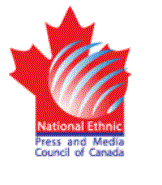
CANADA’S ETHNIC MEDIA:
Fostering
dialogue, forging the engagement and integration of new Canadians,
uniting our communities in Canada’s diversity and multiculturalism
responsibility.
A national socio-economic report on Canada’s community-based ethnic/third language media
Report
Prepared By:
Professor
Dr. Gabriel A. Huston
Seneca
College
For:
National
Ethnic Press and Media Council of Canada
Conseil
National De La Presse Et Des Medias Ethniques Du Canada
![]()

We acknowledge the contribution received from the Government
of Canada through the Canada Periodical Fund of the Department of
Canadian Heritage.
The
following has been requested and provided by the Department of Canadian
Heritage for inclusion in this report as part of the department’s
standard policy.
“The
content of this study represents the opinions of the authors and does
not necessarily represent the policies or views of the Department of
Canadian Heritage or of the Government of Canada. Le contenu de cette étude exprime l’opinion des
auteurs et ne traduit pas nécessairement la politique ni le point the vue du Ministère du Patrimonie canadien ou du gouvernement du
Canada.”
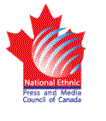
The
following information is provided by Seneca College and the author with
respect to this report;
“On behalf
of and in cooperation with the National Ethnic Press and Media Council
of Canada (NEPMCC) Seneca College was contracted by the NEPMCC to
prepare the NEPMCC approved NEPMCC member survey questions and its
questionnaire. NEPMCC staff administered the member survey questionnaire
online to its registered members via email, fax, Canada Post, in person
and by telephone interview as required by its members. The NEPMCC member
responses and voluntary comments collected by NEPMCC through September
30, 2011 were submitted to and analyzed by Seneca College. The NEPMCC
survey analysis and responses contained in this report represent the
socioeconomic profile, opinions and views of the members of the NEPMCC
who participated in the survey. The balance of content of this report
represents the author’s observations based on the survey results and
analysis and a significant body of existing academic socioeconomic
research and study, which is a body of information and statistics in the
public domain, often with embedded wiki technology. This content was
supported by a supplemental public poll and interviews conducted by the
author. Any views or opinions expressed in this report are not
necessarily the views or opinions of either Seneca College or the author
of this report. Best attribution efforts have been made to correctly
acknowledge and reference the material of original authors whose works
offer a window to academic thought related to ethnicity and ethnic
media. Seneca College and the author acknowledge the copyright of any
such intellectual property. To ensure proper attribution this report has
been scanned through SafeAssign™, Seneca
College, a Blackboard Learning System Enterprise Client. Any release of
information contained in this report is in accordance with the Personal
Information Protection and Electronic Documents Act (PIPEDA), Office of
the Privacy Commissioner of Canada.”
Copyright
© 2012 National Ethnic Press
and Media Council of Canada
FOREWORD
ETHNIC
MEDIA HAS TRANSFORMED
THE
CANADIAN MEDIA LANDSCAPE
October
23, 2012
TD Bank Group is a proud supporter of the National Ethnic
Press and Media Council of Canada (NEPMCC) and its dedicated membership
of ethnic print, radio and television outlets. At TD, we truly believe
that ethnic media’s grassroots reach fulfills a unique function that
serves to promote civic engagement and build a sense of community across
Canada.
Canadian ethnic media has helped transform the media
landscape providing newcomers to Canada relevant and timely information
in their language of choice from a variety of perspectives for over 150
years. Ethnic media’s ability to inform, report, educate and entertain
Canadians has helped to showcase and preserve diversity of culture,
heritage and language within the great Canadian cultural mosaic.
The NEPMCC for the past 25 years, under the leadership of Mr.
Thomas Saras, has helped transform the media landscape by providing
Canadian ethnic media outlets with a common voice for advocacy,
assistance and cooperation helping them grow and succeed in an
increasingly competitive media environment.
At TD, our support for the NEPMCC is grounded in our belief
that, as an organization, our contributions to the social and economic
development of communities must be enduring and compelling. We strive to
make a positive impact where we do business and where our customers and
employees live, work and play.
With over 85,000 employees around the world and our community
giving reaching $44.5 million in Canada this year, TD is in a unique
position to collaborate with the NEPMCC to harness our collective
expertise and resources for greater community impact. Our belief in
partnering with community organizations to help broaden public awareness
aligns with our investment in the NEPMCC’s National Socio-Economic
Report and its dissemination across Canada.
As ethnic press continues to
evolve and transform, TD hopes to engage, connect and enrich diverse
local communities in meaningful, long-lasting and innovative ways.
Scott
Mullin
Vice
President, Community Relations
TD Bank
Group
The
content of this study represents the opinions of the authors and does
not necessarily represent the policies or views o
f
TD Bank Group.

NATIONAL ETHNIC PRESS
& MEDIA COUNCIL OF CANADA SURVEY
COMMENTS
Congratulations to the National
Ethnic Press and Media Council of Canada for undertaking this important
and timely study on Canada's community-based ethnic/third language
media.
This study reflects the needs
and problems of Canadian ethnic media as they try to integrate new
immigrants into Canadian culture. It also creates an awareness of the
problems and needs that various ethnic media face as they try to serve
Canadians in their local communities.
This study should serve as a basis for soliciting funds
from the Government of Canada since ethnic media serve a great and
important role in ethnic communities by introducing newly arrived
immigrants to Canadian culture.
Respectfully,
Pandelis Halamandaris
Professor Emeritus
Brandon University
----------------
"This study provides an important snapshot of
the economics that underpin ethnic news organizations and the challenges
– both journalistic and financial – that many of these small
businesses face as they try to fulfill important roles in their
communities. Respondents voiced concerns about competition from the
Internet, lack of training opportunities and the need to hold down other
jobs just to keep afloat. This is not a business for the faint of
heart."
April Lindgren
Associate Professor
Ryerson University School
of Journalism
----------------

Contact Information
Thomas Saras, President and Chief Executive Officer
National Ethnic Press and Media Council of Canada
Toronto
City Hall Press Gallery, 100 Queen Street West
Toronto,
Ontario M5H 2N2
T:
416.921.8926 / 416.921.4229 F: 416.921.0723
www.nepmcc.ca Email: saras@pathcom.com
Dr. Gabriel A. Huston, Professor
Faculty of International Studies, School of International
Business
Seneca College
1750
Finch Avenue East, Room B-3080
Toronto,
Ontario M2J 2X7
T:
416.491.5050 ext. 26707
www.senecac.on.ca Email: gabriel.huston@senecac.on.ca
Angela Zigras, MDE
Academic Chair, School of International Business, School of
Tourism
Seneca College
8
The Seneca Way, M-452
Markham,
Ontario L3R 5Y1
T:
416.491.5050 ext. 77531
www.senecac.on.ca Email: angela.zigras@senecac.on.ca

Table of Contents
Early
Press, Language and Culture
Merging
Third Language and Mainstream Media
Technology:
the Internet, Social Media and Culture Changes
Grass-Roots
Dialogue as Catalyst
Transforming
Industry Structure
Mainstream
vs. Third Language Media
Viability
and Sustainability of Small Independent Publishers
Social
and Economic Survey of National Ethnic Press and Media Council of Canada
Membership
Portrait
of an Ethnic Media Pioneering Family
Expected Changes in the Ethnic Media Industry
Reason for Change in Expected Revenue
Reason for Change in Staff Size
Suggestions to Encourage Young People to Read

Report from the President
NATIONAL
ETHNIC PRESS AND MEDIA COUNCIL OF CANADA
CONSEIL
NATIONAL DE LA PRESSE ET DES MEDIAS ETHNIQUES DU CANADA
Canada’s Other Voices
For the nearly 40 per
cent of the Canadian population whose mother tongue is neither English
nor French, Canada’s ethnic press and media perform a unique function
within mass media. Their primary purpose, and especially through
Canada’s ethnic press, is to inform readers and viewers in a language
more readily understood than in Canada’s official languages, and by
doing so provide a gateway to understanding and becoming Canadian. By
serving Canada’s various ethnic communities our ethnic press and media
fulfill a role which goes beyond serving the internal needs of immigrant
communities.
For more than 11 decades
Canada’s ethnic newspapers have been meeting the needs of assistance,
guidance and integration of millions of newcomers who have immigrated to
Canada from many lands. They perform this role in full awareness of and
with a great sense of duty and responsibility to Canada, which is
defined by many cultural and linguistic communities.
In addition to providing
important news, Canada’s ethnic press and media provide key
information about settlement issues, community and official languages
learning programs, and health, immigration and work policies and
services. They introduce new Canadians to our democratic institutions
and a new way of living in a new country. To these new Canadians who, at
one time or another, may have found themselves restricted by language
barriers in a country whose laws, traditions and customs were different
from their own, Canada’s ethnic press act as a guide, interpreter,
teacher and as an intimate and trusted friend.
By introducing members of
immigrant communities to new community environments and Canada’s
socioeconomic system as efficiently and as painlessly as possible,
Canada’s ethnic press equally serve individuals, families, all
communities and all stakeholders. By fulfilling this role Canada’s
ethnic press helps newcomers to become full-fledged Canadian citizens,
ready, willing and able to contribute their talents and abilities for
the benefit of all Canadians.
Classical democratic
theory always viewed democracy as a set of institutions, which both
promoted and depended on the full rational development of the
individual. Canada is a nation of many nationalities, many races, many
religions and many languages, bound together by a single unity, the
unity of freedom, tolerance and equality.
In support of the Canadian Charter of Rights and Freedoms it is
crucial that the place of every minority group in our society not be
obscured by ignorance, prejudice or racism. It is important that the
members of every community have the ability to discuss and consider
among themselves their special problems, so that these problems may find
expression for the benefit of our broader society. Here, access to
language is also central to preserving Canada’s multiculturalism and
diversity.
The ethnic press
importantly ensures that our liberties, our democratic way of life, our
freely elected representative government make it possible for us to
participate, agree or disagree among ourselves in our language of choice
over ideas and institutions without bitterness or misunderstanding.
Through access to a common language is the fundamental truth that
linguistic groups, which were divided abroad, are united here in Canada.
Globalization and other
forces today are changing many traditional parameters in the way that
government is exercised and how society views itself. Because of these
developments it is important to acknowledge that Canada’s ethnic press
demonstrates a high level of education and competence to meet the
ethical and social responsibilities of such change. In the reality of
the socioeconomic challenges that Canada’s ethnic press face daily we
must support our ethnic press and media as they are serving Canada, they
are helping new immigrants to understand and integrate as quickly as
possible into mainstream society to be productive citizens in the
broadest sense of Canadian community.
Canada today is in a
period of socioeconomic change in a world that is becoming smaller and
smaller, looking for new markets and searching for new partnerships. In this context the ethnic press and the ethnic communities
it serves is an important participant in both process and progress.
This reality underlines
the importance of this survey and the fact that we need to know the
problems and the needs of the members of Canada’s ethnic press as it
is our democratic public responsibility to provide them with tools
through education and financial assistance in order to make sure that
the information they provide is accurate, complete and consistently
accessible and not limited by economic factors. This is the first and
only survey of its kind ever conducted at a national level in Canada, a
fact that makes this survey very important.
The members of the
National Ethnic Press and Media Council of Canada express gratitude to
Seneca College and to Angela Zigras and professor Dr. Gabriel Huston for
their hard work, enthusiasm, consultation and help provided in order to
complete the NEPMCC survey process to the best of our ability as
expressed in this report in order to help improve the futures of the
members of the ethnic media sector and the communities which it serves.
Our thanks and gratitude is also expressed to the Department of Canadian
Heritage, the Canada Periodical Fund, and TD Bank Group for the
financial assistance they provided toward the successful completion of
the NEPMCC survey.
Thomas S. Saras
President and CEO
NATIONAL ETHNIC PRESS AND
MEDIA COUNCIL OF CANADA
CONSEIL
NATIONAL DE LA PRESSE ET DES MEDIA ETHNIQUES DU CANADA
National Ethnic Press and Media
Council of Canada / Conseil National de la Presse et des Media Ethniques du
Canada
Toronto City Hall Press Gallery, 100 Queen Street West,
Toronto, Ontario M5H 2N2
www.nepmcc.ca E: saras@pathcom.com T: 416.921.8926 / 416.921.4229. F: 416.921.0723

Executive Summary
Companies that own and/or operate community-based ethnic (third language) media enterprises in Canada fall into two main categories, each with unique attributes, business, economic, strategic and sustainability needs profiles in the better service of their communities.
These
two categories are:
-
Small to medium media enterprises, which represent the majority of
independent ‘owner/operator’ and ‘family partnership’ which fall
into a polarized organizational structure. This group represents the
majority of Canada’s ethnic media businesses serving the broadest
representation of Canada’s multicultural and third language diversity.
Within this group we observe the widest range and depth of multiple
needs and hurdles with a common core value to ‘better serve our
communities’.
-
Large media enterprises which are mostly commercial and often commodities
and transactional in their mission, structure and outlook. This group
represents highly focused needs to better serve large, urban immigrant
communities and demonstrate strong economic capability, competence and
strength to identify and capitalize on new markets, services and
opportunities to identify, capture and hold their major audiences.
Together, these two ethnic media categories effectively reach
Canada’s ethnic communities and speak to Canada’s immigrant and
visible minorities, which, according to Statistics Canada will be one
out of every five Canadians by 2017, with highest concentrations in the
urban centres of Toronto, Vancouver and Montréal respectively.
Seneca College was contracted by the National Ethnic Press
and Media Council of Canada (NEPMCC) to prepare the survey questions and
cooperated with the NEPMCC across the survey process through the
analysis of findings toward the writing of this report.
Several key NEPMCC Survey questions related to the
socio-economic of Canada’s ethnic media industry reveal blind spots,
gaps and statements of need (cries for help) to be better able to serve
the community spectrum of Canada’s ethnic diversity, particularly
within the small to medium size ethnic media enterprise category.
The key questions and findings interpreted from the NEPMCC
survey include:
What is the predominant organizational model? What kinds of
ownership?
The
predominant organizational model for the majority of NEPMCC survey
respondents is as ‘independent owner/operator’. This
organizational form demonstrates large variances between traditional
organizational functional activities or ‘operational matrix columns’
such as administration, finance, marketing, production, research and
sales, against horizontal ‘organizational matrix rows’, which are
the core business activities or product areas that the business derives
its income and profit from. The main reason for such variances is the
multiple focus and time demand imposed on management to simply keep the
organization afloat and running.
It
is also observed that many NEPMCC members also have day jobs in addition
to their ethnic media enterprise management and operational
responsibilities. They must work from two perspectives, often balancing
different skill sets and unstable resources to manage dual
responsibilities to stay current and succeed. This dual orientation and
responsibility means that their effectiveness is often imbalanced and
they cannot function optimally as effective managers.
Another
observation is that small to medium size third language media operators
encounter difficulty in attracting and retaining staff to develop human
capital and management potential. This negatively impacts effective
organizational growth planning with the result that staff see their jobs
in small to medium ethnic media companies as a first step to a career
with a larger media organization. This makes it difficult for small to
medium size ethnic media operators to build team presence, dynamics and
commitment within their organizations.
This
reality does not provide the necessary organizational climate for
adaptability, innovation and change that is required to succeed in the
challenges of the emerging third language media industry. Large, ‘fast
growth’ third language commercial media operators may view small to
medium size third language media operators as acquisition targets and
are perceived by small to medium sized operators as a threat to their
ability to profitably compete for necessary advertising dollars and
representative ‘space’ in Canada’s third language media market
presence.
A
team-based network of interaction with a learning-oriented
business-to-business approach is needed to meet the challenges of the
local environment, hedge against polarization between small to medium
size and large ethnic media enterprise operators and identify growth
opportunities that uniquely emerge from balanced and open industry
collaboration.
Where
smaller third language ethnic media operators encounter further
complexity and threat to organizational integrity is through the
sub-contracting of key functions, which is reported in the member data.
Following
are some of the elements that prevent effective organizational
development and innovation within Canada’s third language media
industry at the small to medium size organizational
level:
-
Problems cited
more than
solutions;
-
Organizational
advancement and innovation are associated with a high price tag and
additional demand on already over-stressed owner/operators;
-
This type of
organization is an excellent apprenticeship and learning ground for
media and community/social diversity training, but there is absence of
support, direction and mechanisms for continuous professional
development and improvement;
-
Innovation is
difficult because the point of business focus is survival. As a result,
the dynamic of change has little chance of being implemented;
-
Multiple
approaches are difficult to model because of the absence of an industry
structure that funds and supports new organizational and business
modeling incubator, while representing cultural diversity organizational
diversity is threatened;
-
Team
building for profitable growth and partnering across the industry
through collaboration initiatives are overshadowed by perceived
operational difficulties.
-
The
development of hard and soft business, creative, journalistic, professional and strategic
and sustainability management skills is difficult;
-
Fear of
risk-taking because of financial limitations is a common entry barrier
to growth and diversification;
-
Creativity,
invention and new leadership opportunities are limited because of staff retention issues;
and
-
Curiosity is
suppressed by the need to focus on operational challenges.
What are
the main challenges and hurdles that ethnic media editors encounter from
an economic perspective?
From an
economic perspective the main challenges that ethnic media editors face
include the lack of financial and human capital resources to build
editorial team strength to fully access and serve the communities and
groups that they represent; be it reporting on key community discussion,
events and issues, or interfacing with mainstream national and global
media to fully develop and advance editorial perspectives on the issues
that affect their communities. As such, editorial interactivity is
limited by the financial and human capital resources of the small to
medium size ethnic media companies and in many ways is outweighed by the
mainstreaming of broad editorial themes by large ethnic media
organizations.
Additionally,
with many ethnic media editors holding full time jobs because of
economic necessity, barriers are presented to having free access to
relevant press conferences that would enrich the quality and diversity
of their editorial content.
How many
and what type of jobs do ethnic media create?
More
comprehensive research will be required to accurately determine how many
jobs ethnic media create nationally. It is important to acknowledge that
the diverse types of jobs that ethnic media creates positively
contribute to Canada’s economic growth through emerging consumer
audiences with powerful disposable income and in the following
areas/ways:
-
In the printing industry supply chain and its related delivery
mechanisms;
-
In radio and television industry viability at both the large commercial
enterprise level and through buying blocks of otherwise marginal income
air-time by smaller ethnic outlets that revitalize that airtime to reach
new audiences;
-
Stimulating the businesses of the advertisers who rely on ethnic media to
drive sales to ethnic markets and thus generate new jobs for third
language speaking labor forces; and
-
As a ground level enterprise, employment and skills development
opportunity for talented immigrants whose skills would otherwise be
under-utilized in other forms of work.
What is
the educational background of the publishers and editors of ethnic
media?
The
majority of the publishers and editors of Canada’s ethnic media
outlets are educated to the higher level with over two thirds having
attained a university degree or higher. They represent a
community-minded, intellectual, mature body of professionals who
contribute significantly to the rich diversity of Canada’s media
landscape.
What are
the links between ethnic media outlets and the communities they serve?
The links
between ethnic media outlets and the communities they serve are a
multi-dimensional interwoven tapestry truly representative of Canadian
community, national, transnational and global communication, culture,
diversity and society, and cannot be viewed in a linear fashion. The
links and the communities they serve include, among others:
-
Canadian ethnic media outlets directly with Canadian local communities;
-
Canadian ethnic media outlets directly with Canadian regional and
national communities;
-
Canadian ethnic media outlets directly and indirectly with international
communities,
-
Canadian ethnic media outlets with mainstream media;
-
Canadian ethnic media outlets with government and community service
agencies;
-
Canadian ethnic media outlets with each other through NEPMCC;
-
Canadian transnational ethnic media outlets internally with
affiliate/parent media outlets; and
-
Canadian and Canadian transnational media outlets globally across wire
services (Associated Press, Reuters), the Internet and social media.
How does
the economic factor influence the quality of the content and how does
this impact the market in which they operate?
There is
clear and ample demonstration that the economic factor significantly
influences the quality of content across Canada’s third language media
and both the existing and potential markets in which they operate. Key
influencing factors include access to capital and government support for
entry, solvency, sustainability and growth of small to medium size
ethnic media outlet operators, free vs. paid media, community/public
service vs. commercial balance, economic scales of efficiency and
maintaining balanced presence with both mainstream and emerging
commoditized ethnic media operators. These influencing economic factors
coupled with the imperative to identify and secure predictable streams
of advertising revenue from advertising agencies by providing reliable
audience research and data and the need to compete with mainstream media
for available advertising budgets impact the market in the following
ways:
-
New categories of market entry opportunity such as ethnic marketing to
supplement traditional media offerings and develop better research tools
to determine the quality and direction of content;
-
Restricted market presence and narrow distribution channels sets entry
barriers for small to medium size outlets to finance content quality
improvement;
-
Need to focus on securing local advertisers for small to medium size
outlets with restricted quantity and quantity of content;
-
Limited ability of both small to medium size and large outlets to attract
specific interest groups such as youth who perceive ethnic media in
general to be too focused on older generations; and
-
Restricted markets and cross-cultural market interface mean costly and/or
limited access to national opportunities and broader dialogue for more
expanded, quality content.
Their collective voice is clear - forge a unified direction
for sustainable business opportunity and growth, professional training
in business and strategic management and professional skills development
related to journalism; create unified media and audience measurement and
research tools; open business opportunities through new communication
technologies; assist our small to medium size members to minimalize
business risks and promote deeper interactivity with Canada’s
formative immigrant communities.
A review of the history and evolution of ethnic media in
Canada and today’s forces of diaspora, globalization and immigration
are described in this report. These forces shape the nature, direction
and future of ethnic media in Canada.
An overview of leading thought and research related to
ethnicity, ethnic media, immigration, media evolution and socio-economic
indicators offer a snapshot of the diversity environment in which
Canada’s ethnic media industry seeks economic sustainability in
improved community-based service, particularly in helping new Canadians
to settle and integrate.
One of the first challenges in understanding Canada’s
ethnic media industry was to correctly position the concept of ethnicity
and ethnic media and its varied interpretations in line with the rise of
Canada’s ‘visible minorities’ to their established position as
mainstream consumers, an emerging population that is redefining Canadian
culture, identity and society. It is important to communicate that the
terms describing ethnic media are often used interchangeably and it is
often difficult to trace the origin and/or precise meaning of certain
terms as they may have different meanings adapted and related to
locality, country or region of usage, that it is immigration, migration,
societal change and local sensitivities that shape their origin, meaning
and popularization.
An example is that the terms community media, ethnic media,
geo-ethnic media, intercultural media, multicultural media and third
language media have been all used to refer to the generic term ethnic
media, yet each reflects a particular development in sociocultural
thinking arising most notably from local or regional study by social
scientists and the cultural sensitivities of local populations.
In this report Canada’s ethnic media are referred to as
third language media, placing our ethnic media on a level playing field
with Canada’s mainstream media in our two official languages, English
and French.
This report establishes and discusses from multiple
perspectives the central role that Canada’s third language media
uniquely fulfil in promoting Canadian intercultural diversity, dialogue,
heritage, community and civic engagement. This role is central to both
Canada’s ethnic media industry and Canada’s socioeconomic progress.
Emerging trends are documented focusing on the pressures upon
and the marginalization of Canada’s third language media from without
and from within; the commoditization and globalization of dominant third
language Asian markets, and the ‘we’ vs. ‘they’ attitudes that
linger to delineate third language media from the ‘mainstream’ in
the new reality that Canada’s third language media are an emerging
mainstream. The link between geography and ethnicity is documented as is
the necessity for a more proactive ongoing national approach to third
language media and social research for best practices and continuous
improvement.
As a supplement to the results of the NEPMCC Survey an
independent community poll on Canadian third language media was
conducted in the GTA and surrounding area during December 2011 and
leader views were received as a SWOT analysis concerning Canada’s
third language media. This limited public opinion demonstrates strong
support of Canada’s third language media as a major component of
Canadian life, culture and community.
From the NEPMCC survey four critical areas of need are
identified to foster a vibrant, balanced, economically sustainable third
language community-based media industry in Canada.They are:
-
Canadian media industry-wide discussion, collaboration and synergy with
Canada’s community based third language media industry;
-
Increased public sector interface and government support;
-
An array of professional skills development, research tools and strategic
management assistance for the third language media industry; and
-
Identification of and equal access to innovative products, markets and
partnership opportunities for stability and sustained growth.
While this report is positioned and presented as a general
overview containing specific survey results from a limited
representative sample of NEPMCC members from a socioeconomic
community-based perspective, it is national, current, timely, and its
recommendations are well positioned to stimulate thought, discussion and
proactive engagement in the fast paced global communication,
intercultural and societal realities that Canada’s third language
media industry is a dynamic, integral, interactive and formative part
of.
Across this offering of a tapestry of perspectives in new
Canadian realities three words are pivotal to further discussion related
to third language media.
They are community, help and now.
Introduction and Overview
Statement
All life needs communication to survive. From colliding
protons at the cellular level through communication between individuals
and across societies, reflecting back through self, group, community,
national and global identity, all life truly is interconnected.
Canada’s ethnic media industry is a vital national
communication link, one that is at risk of being marginalized yet
possesses great potential to dynamically evolve to create new space in
the global tapestry of human diaspora and the formation of new Canadian
communication highways in our age of media convergence and emergence
through new information and communication technologies.
In this report Canada’s ethnic media tapestry is overviewed
from both national and global perspectives. Its pivotal role in
cultural, political and social research is defined and recognized as a
central pillar in Canada`s communication ecology, identity and
development infrastructure for better opportunities based on community
life and public engagement.
Through this report Canada’s ethnic media is seen in the
context of culture, globalization, current research, and emerging trends
that recognize Canada’s ethnic media as our distinctively Canadian
third language media, an emerging mainstream media and touch-point of
how Canada and being Canadian is perceived within Canada and around the
world.
While this report makes recommendations across those areas of
most urgent need to support a dedicated climate of growth for Canada’s
third language media, it is at the same time a clarion call for Canada
to create a world class centre of diversity excellence in communication
where third language media education, professional skills development
and research can find a home in the advancement of Canada’s
communication and socio-cultural innovation ‘know-how’.
In his 1964 book Understanding Media: The Extensions of Man
Marshall McLuhan coined the phrase “The medium is the message.”,
proposing that it is the medium before its content that should be a
focus of communication study, that a medium affects society through both
the content delivered across and by the characteristics of the medium.
To elaborate, McLuhan used the analogy of the light bulb as a medium
without content and stated “a light bulb creates an environment by its
mere presence.” (Em)power it and there is illumination.
It is the vital presence of and accessibility to third
language media in the Canadian communication landscape that is the
message, setting a “cascade of interactions” in our evolving
intercultural self-identity and provides a platform for discussion,
interactivity and engagement. Similarly it is the forum that Canada’s
third language media presents that gives shape, structure and substance
to our public attitudes, norms, values and social implications.
Background
Across the summer of 2011 and concluding on September 30,
2011 members of the National Ethnic Press and Media Council of Canada
were surveyed about their business challenges from the perspectives of
current business operating platforms, content and distribution and
audience base.
The members surveyed were also asked to consider and respond
to top-of mind challenges and solutions, prompted internal and external
issues and expected changes in Canada’s ethnic (third language) media
in the next three years.
Members expressed concern for the future of their industry,
ongoing government involvement and support and competition from
‘mainstream’ media’. The members demonstrated split opinions
concerning changing demographics and Internet opportunities and
obstacles.
The NEPMCC Survey lead to several recommendations including
providing members with training in business management, marketing,
creative problem-solving, leadership and succession planning, creating
synergy with other members, ways to attract new and young adult
audiences and the need for government to ‘fill the gaps’. As one
member described Canada’s ethnic (third language) media, we are ‘the
voice of Canada’.
The NEPMCC Survey results prompted thought on the challenges
that Canada’s third language media face in our globalizing world.
Discussion with media industry leaders and a poll of the general
public’s third language media habits were independently undertaken by
the author to offer additional viewpoints which are detailed in this
report.
Learning
Tree Approach
This report takes a learning tree approach to the subject of
ethnicity in Canada and establishes Canada’s third language media
industry’s importance to Canadian culture, heritage and identity and
establishes the need for comprehensive, ongoing national research and
study of Canada’s third language media from a socioeconomic
perspective.
The intercultural communication tapestry presented in this
report positions Canada’s third language media as way to understand
and further study Canada as a communication nation empowered by
diversity.
As varied and complex as the study of ethnicity and diversity
is, it is the concept of a healthy thriving communication learning tree
that is the communication message of this report. Canada’s third
language media industry must be viewed organically within Canada’s
functioning communication universe, not as a branch or aspect of
Canadian media.
In the spirit of the learning tree approach the NEPMCC Survey
necessarily lead to community discussion and media leader interviews
throughout December 2011 to frame this report in broader terms relating
to ethnicity in Canada, heritage, immigration, settling and community
development, community integrity and economic
viability.
Content
of Concepts
The word ‘ethnic’ has complex, often varying meanings. In
general terms, an ‘ethnic group’ is a ‘group of people whose
members’ self-identify and same group-identify through some or all of
a common culture, heritage, homeland, language and traditions’. This
self and same group identification may or may not include a shared faith
and/or a common ancestry. Common social characteristics of an ethnic
group may often include a sense of belonging to that group and
recognition from others of the group’s unique characteristics.
The modern use of the term ‘ethnic group’ emerged with
the popularization of the social sciences as a way to study and
understand national and group identities and populations in the face of
the broad movement of people and cultures that began with
industrialization. The terms ‘ethnic’ and ‘ethnic group’ and
have often been applied to immigrants and incorrectly to First Nations
people, often with prejudicial and racial overtones in
self-protectionism of a perceived national identity by a cultural
mainstream in the throes of social change or a threatened ‘norm’
because of the presence, visibility and voice of minorities within a
cultural mainstream.
Of note is how visible minorities often reference themselves
within the concept of a national identity, using ethnic group identity
before national identity as a way to distinguish and value ethnic
identity within a national identity. Examples of this include
‘Italian-Canadian’, ‘Afro-American’, or any possible combination
where the ethnic group identification precedes national identification.
This observation is particularly important when discussing
ethnicity and the ethnic media in Canada because of Canada’s strong
historical and current patterns of migration, immigration and settlement
from many distinctive ethnic groups to form our great nation that
self-identifies and defines itself as a pluralistic tapestry of
cultures, as opposed to being a ‘melting pot’ in nationhood.
In Canada today, with such great cultural diversity in
evidence largely driven by immigration, it is proposed that the study of
ethnicity as it relates to ethnic media must be approached from the
perspective of an interrelated communication whole within a national
social identity based on language and representative populations.
In Canada major Asian media serving pan-Asian Canadian
audiences necessarily appeal to their audiences through the most common
language(s) in usage. However, it is the presence of small to medium
third language publications published in any number of languages and
dialects that serve in a more meaningful way to preserve cultural
diversity and community dialogue in the face of dominant regional third
language media presences in Canada.
What is important to the purpose and understanding of third
language media in Canada is the vitality and voice of ethnic inter-group
interactions through the forms of communication that Canada’s third
language media industry uniquely presents as a distinctively Canadian
cultural communication universe in dynamic global intercultural
evolution.
Kim, Jung and Ball-Rokeach in 2006 observed that ethnicity
and geography clearly affect and are affected by each other. They termed
this relationship as ‘geo-ethnicity’, meaning that no two
communities can be assumed to be the same, even if they seem appear to
be similar. Geo-ethnicity is a symbiotic relationship and it is the
dynamic interaction between geography and ethnicity that is central to
understanding the experiences of ethnic groups and new Canadians, and in
this report the vital role in communication that Canada’s third
language media industry fulfils.
Third language media in Canada reflect the multi-faceted
complexity of the daily lives of their target audiences and society in
general, both within Canada and internationally. From relating news and
events from a native homeland where the media may be censored or
supressed, to relating new Canadians’ experiences and preserving
shared values through settlement and community formation. Canada’s
third language media extends beyond culture and ethnic identity to
communicate what it is to be a Canadian, and in doing so assist Canada
to define Canadian culture and govern its sovereignty.
Hofstede (1984) observed that ‘culture is learned, shared
and guides members of a society to solve every day problems’. From
this perspective the content, context, shape and texture of third
language media in Canada can play a vital role in identifying problems
at a grass-roots level and assist to discuss and develop societal
problem-solving competency.
If the differences and common characteristics between
Canada’s cultures can be documented, observed and compared through the
tapestry that Canadian third language media represent, we can better
appreciate the symbiotic nature of Canada’s third language media
within the totality of Canadian society.
Hofstede (2001) says that culture resembles an iceberg. Using
Hofstede’s concept of the cultural iceberg, consider that an iceberg
is not static. It is contained by and moves in a current, its shape and
direction both above and below the waterline being constantly redefined
where in fact the iceberg contributes to that which contains it. Such is
the nature of culture. It is a dynamic flux and its study must be a
study in movement, interaction and constant change. Here, particularly
third language media can effectively serve as a barometer to measure the
cultural aspects of that constant change.
In this reality, recent studies on third language media in
Canada which primarily focus on Canada’s metropolitan areas must be
appreciated within the context of dynamic flux. Certainly the results
and analysis of the data that will emerge from Canada’s 2011 census
will assist greatly to validate and update assumptions.
Further, if the study of third language media in Canada can
be compared to a portion of the 10 per cent of the cultural iceberg that
is visible and measurable above the water line, the 90 per cent below
the water line represents the significant cultural and social dynamics
that shape Canada’s communities, economy, national identity, legal
system, politics and our future as a nation.
Strategic cultural influencers below the water line include
the forces of globalization of all media via the Internet, youth
fascination with popular culture and the rapid emergence of new
communication technologies and their influences on culture to name a
few.
Turner (1982) defined three dimensions of ‘ethnic
identity’; self-identification as a member of a particular ethnic
group, knowledge of the ethnic culture, and feelings about the behaviors
that demonstrate belonging to the ethnic group.
Canada’s ethnic tapestry reinforces that these dimensions
are constantly shifting. For example, a Canadian youth may self-identify
as being ethnic but her/his ‘pop culture’ enculturation may not
include a profound understanding of the beliefs, norms and traditions of
an ethnic background or fluency in a third language. Further, a child of
mixed ethnicity may choose to self-identify with one background, and a
child that demonstrates little knowledge of her/his ethnic culture may
have strong feelings of belonging to an ethnic group.
The point of these illustrations is that ethnic identity is a
fluid state and fostering a communication climate that embraces
intercultural fluidity of identity is a function that Canada’s third
language media uniquely fulfil.
Accessibility to a broad and vibrant tapestry of third
language communication promotes the understanding of both self and group
identification within the contexts of community formation and
engagement, ethnicity, heritage preservation, intercultural
understanding and societal evolution.
Current Canadian social researchers, including Lindgren, have
observed that Canada is the world’s most ethnically diverse nation.
Their work competently illustrates how Canada’s communities are
defined by regional and most notably complex urban identity. How people
evolve their ethnic identity through everyday life in Canada is in part
influenced by available communication options, access to local
communities and exposure to people who speak a different language.
From the perspective of the Canadian immigrant, a newcomer to
Canada living in a large metropolitan center with a significant resident
population from a similar background and access to broad ethnic media
exposure may self-identify, settle and integrate into community in a
different manner than the same person who settles in an isolated
Canadian community. Their ethnic identities will evolve and re-define,
but not necessarily in similar ways.
Through language an immigrating culture develops and evolves
their Canadian ethnic identity, voice and the process of social and
community involvement through everyday life and daily interaction in
Canada. The common ground and forum for dialogue and exchange between
the new immigrant and Canadian society may often be via joint access to
and communication through and across third language media.
Through open dialogue and exchange societies can minimalize
the risks associated with making false assumptions about cultural and
social differences, or the biases that arise from any feelings of
cultural superiority or inferiority.
By promoting open dialogue and exchange, Canada’s third
language media truly serve as champions of a “just society”. Through
Canada’s third language media society gains access to space for
participation, involvement and evolution through open communication in
the broadest possible sense. It is this open climate that supports
diversity from a grass-roots level up, and can manage the risks of
possible social imbalances.
Research
for Best Practices
Through social scientists we observe, measure and describe
the intricacy of the evolving human cultural tapestry. This report
acknowledges the need for best practices in social research but places
equal emphasis on simply understanding the dynamic flux of social
perceptions about ethnic identity that is difficult to measure and
define in pure research terms. Put simply it is those common values that
groups seek to share that promotes understanding and evolution of both
ethnic identity and society.
Rather than creating new definitions of ethnicity through
communication, Canada’s third language media industry is presented as
an essential barometer and primary lens through which researchers can
effectively engage in their study of Canadian culture and society. To do
so Canada’s third language media industry must function effectively,
ethically, professionally, profitably and sustainably.
By supporting best practices in Canada’s third language
media industry Canada can gain strategic communications and social
research advantage by the exchange of perspectives. Proactive promotion
of this climate is necessary for Canada’s intercultural and societal
evolutionary process.

Welcome
Dear Friends and Fellow Canadians:
When Angela Zigras, Academic Chair School of International
Business at Seneca College, suggested that I write this report on the
social and economic dynamics of Canada’s ethnic media resulting from a
survey of the members of the National Ethnic Press and Media Council of
Canada (NEPMCC), I was at once honoured, humbled and frankly terrified.
I was honoured, because this report is Canada’s first truly
national study of our vibrant third language media. Coming from a
multiple ethnic background both by birth and from inclusion, I was
humbled to write this report because it means so very much to my
families. They taught me to embrace diversity and to view ethnicity as
being the warp and weft of human tapestry - a beautiful learning tree. I
was terrified to write this report not because it is a first national
report and I am the one that is writing it, but because I don’t want
to fall short on any possible expectations.
We all are indebted to our third language media operators who
sacrifice daily to make meaningful communication access and
intercultural dialogue possible for their communities and for all
Canadians. Simply, my intent through this report is to open a window of
opportunity for national discussion on our third language media.
Through meeting Mr. Thomas Saras, NEPMCC’s President &
CEO, I immediately came to appreciate his deep commitment and life-long
dedication to Canada’s third language media and ethnic communities
that finds their roots in over 150 years of ethnic media legacy that
welcomes those who come to Canada to make a new life, and in doing so,
preserve culture, heritage and language while being the driving catalyst
in the formation and evolution of Canadian multiculturalism, diversity,
economy, heritage and society.
From my investigations I learned that ethnicity and ethnic
media are closely related to community, geography and story-telling -
thank you Sandra Ball-Rokeach.
My personal chapter relating to ethnic media in Canada starts
with a family, my family.
My late father Yousef (Joe) was born in the 1920s in rural
Stead, Manitoba. The youngest of 11 children from immigrant Austrian and
Russian parents they were literally dirt poor. Their first home was
constructed from clumps of prairie sod and they cultivated sugar beets,
directing their profit from that back-breaking work to repay their
passage to Canada, and earn a new life as proud Canadians.
Like many other immigrant families who settled in rural
Western Canada in the early 1900s there were few schools, and those that
did exist operated from churches and were run by those family members
who could read and write. Few books were available and textbooks rare.
Ethnic newspapers from Winnipeg were used as elementary primers.
Story-telling kept homeland memories and cultural heritage burning
bright. There were no blackboards. You just had to remember things and
keep hope and tradition alive by the repeated telling of those beloved
stories. And when a
community was fortunate enough to have the gift of an ethnic newspaper
it was treasured and passed from family to family, regardless of its
language or date of publication.
The ethnic press was their window to Canada and the world
amid bitterly cold winters and isolation. With 11 children sharing two
pair of winter boots there was little opportunity to walk three frozen
miles to attend school when it was open, so the children learned German,
Polish, Ukrainian, Russian and Yiddish at home, then English, largely by
translating government farming and settlement pamphlets when available
in Ukrainian, then placed alongside the corresponding English
publication.
My mother’s family immigrated to Toronto in the 1930s from
Denmark. The children were not allowed to speak Danish at home until
they mastered the English language.
H.J. Tygesen, ‘the grand old man of Canadian art’, my
grandfather, promoted the careers and works of Canada’s Group of
Seven, the central pillar of Canada’s artistic heritage and legacy.
Being avid multilingual readers and heated debaters my maternal
grandfather and grandmother taught my mother and uncles to shape their
minds and views from many different news sources.
They made arrangements for Britnell’s Bookstore which was
next door to ‘L’estampe Moderne’, the family art gallery, to bring
in ‘foreign language’ newspapers and magazines, which were
translated into English and publicly discussed at Sunday afternoon
gatherings in the family gallery. Here, anyone who was interested could
learn about art, culture, fashion, finance, politics, thought and what
was going on around the world.
Growing up in Toronto in the 1950s, my dad, who was a
railroader, and travelled between Montréal and Winnipeg, would
take me with him to places like Moosonee in Northern Ontario on
‘special trips’. He would bring bundles of newspapers in Ukrainian
and French-Canadian to share with his friends, mostly migrant miners,
prospectors and lumbermen. Closing my eyes I can see them waiting on the
station platform looking for ‘Joe and his bundle of newspapers’,
like they were made out of the very gold that they were digging in the
earth for.
On Saturdays at home I fondly remember rushing to the local
drug store with a shoe box containing precious radio tubes wrapped in
the pink pages of the then Toronto Telegram to be tested on the radio
and TV tube testing machine which looked like it came straight from a
1950s sci-fi movie. Dodging potholes I would peddle my bike like crazy
back home, shoebox bouncing in my newspaper carrier, and the new radio
tubes tucked safely under my t-shirt.
Dad would carefully insert the new tubes into his short wave
radio, power it up, fiddle with the dial, press his ear to the speaker
and listen intently for the scratchy sounds of radio programming in
Ukrainian from Winnipeg, or in French from Québec.
Joe was a man who rarely smiled, but on those occasions he
smiled down to his soul.
Jumping forward to the next chapter of my story leading to
this report, today I teach and mostly learn much from international
students at Seneca College. I experience first-hand how profoundly
important third language media are to them. For many of our
international students this is their first time away from their families
and homeland. They are alone in Canada. Through Canadian third language
media they find a sense of belonging leading to community.
By some twist of fate I recently became the adoptive father
of five fine Bataknese Indonesian young people; Cynthia, Baringin,
Binsar, Pandapotan and Pahala Manurung. The Manurung family who live in
Jakarta, Medan, North Sumatra and Dolok Nagodang beside Lake Toba, the
site of the world’s last super-volcano, entrusted the well-being of
their children into my care and have in truth embraced me as their own,
legally, as Batak, Sumatra’s Aboriginal people.
Cynthia, a graduate from Niagara College with top honours is
now studying electrical engineering in the degree program at Lakehead
University in Thunder Bay, Ontario. In the near future she hopefully
will be part of a team that assures reliable power delivery in Ontario.
Currently being the only Indonesian student studying at Lakehead
University, apart from communication with our family Cynthia’s primary
source of current information about Indonesia is through online third
language media.
In a similar manner, Pahala, who is finishing his studies in
international business in Toronto is deeply committed to
humanitarianism, particularly for Batak people in Canada, Sumatra and
world-wide. In the preservation of Batak aboriginal culture, which is
threatened in the modern world, Pahala relies on third language media in
Bahasa Indonesia (Indonesia’s national language) and in Bataknese from
multiple third language media outlets to compare and contrast divergent
editorial opinions and keep Batak culture alive, especially in Canada.
Do the Batak people who have immigrated to Canada have their
own Canadian third language media outlet to share in Canada’s cultural
tapestry? No, but they will, and it will probably be a dedicated
Canadian Batak who will start and sustain the outlet from hard-earned
personal savings because they believe that Batak culture and stories are
part of being Canadian.
So where does my chapter in this story of third language
media in Canada end? It ends with the beginning, and that beginning is
you, the readers of this report to which it is humbly dedicated in the
truth that Canada’s ethnic / third language media are vital in helping
new Canadians integrate and grow strong roots in our socioeconomic
tapestry.
To the members of the National Ethnic Press and Media Council
of Canada and Thomas Saras, thank you for this opportunity to relate
your realities reflected through the NEPMCC survey.
Respectfully submitted,
Dr. Gabriel Huston

The Evolution of Canada’s
Ethnic Media Tapestry
Through Canada’s century plus tradition of ethnic media we
trace our vibrant cultural and historical communication roots and come
to value the importance of third language media as they dynamically
evolve within a panorama of new choices and global interactivity.
Early
Press Language and Culture
From the US Civil War times of black migration to Nova Scotia
across the ‘Underground Railroad’ and the black presses of the
1850s, through the settlement of Canada by Europeans seeking a new home,
immigrants to Canada have relied on printed information in their home
languages to understand, adapt, integrate and maintain a sense of
community and culture.
From the archives and displays of Canada’s Museum of
Civilization we learn that from the 1870s multicultural, multilingual
publishing centre grew with the settlement of Western Canada throughout
the first half of the 20-th century. Publishers in German, Russian and
Ukrainian, to name a few languages, printed a wide range of advertising,
cultural, informative and religious materials in addition to newspapers
that provided a voice to settlers primarily from Europe. Canada’s
early third language press identified important public issues, presented
viewpoints and communicated immigration policy and useful information
related to farming, labour organization and political representation.
Immigrants used the ethnic press to learn how to read in English, and
with that skill immigrants were able to establish and empower themselves
as Canadians.
From the early 1900s Canada aggressively sought abroad and
received great waves of immigration particularly from Europe. Canada’s
third language press was used both as a tool for the settlement of rural
areas and to foster a sense of national identity and belonging across
its vast geography and settling rural and remote areas. In rural Canada
in the 1920s schools were few and far between. The third language press
served as the primary reader for thousands of immigrants seeking a new
national identity and provided advertisers and politicians and effective
way to reach new consumers and voters.
Through the 1920s and 1930s Western Canada’s third language
press also became a vehicle for labor union and socialist organizers to
motivate and mobilize immigrants. The voice of foreign press was also
present in Canada’s third language publications. With the fear and
suspicion associated with Russia’s Bolshevik Revolution and World War
I the Canadian government prohibited publications in languages which
included Ukrainian and German.
The ban was lifted after World War I but for a period
Ukrainian and Canadian ethnic publishers were mandated to publish their
copy accompanied by a translation in either English or French.
It was the emergence of Greek-language and Italian-language
urban newspapers during the 1940s and 1950s that invested Canada’s
third language press with a truly national sense of presence (Yes,
ethnic newspapers do have a life-span. They are treasured and widely
shared). From Montreal’s early Italian-language newspapers, Il
Cittadino Canadese, Il Corriere Italiano and Corriere Canadense,
readership and demand expanded with booming Italian immigrant
populations in Toronto and beyond.
Where today Corriere Canadese is Canada’s only daily
Italian-language newspaper, behind successful third language press
enterprise there is a documented historical pattern of third language
newspapers and magazines that are founded by recent immigrants and
either fail or are published infrequently due to financial problems
and/or lack of funding.
According to the Media Awareness Network (2008) at that time
there were more than 250 third language newspapers including weeklies
and seven non-English dailies in Canada predominantly serving large
urban areas such as Montreal, Toronto, Vancouver, and Montreal,
representing more than 50 cultures and over five million Canadians who
identify with a third language. Today Québec has a vibrant third
language media presence, Canada’s First Nations have dedicated media
presence as a constant beacon to illuminate many Canadian paths of
thinking in diversity and Dr. Catherine Murray’s 2007 Simon Fraser
University Report Cultural Diversity and Ethnic Media in BC has paved
the way for Canada’s media industry to embrace diversity through
multiculturalism as a core Canadian value.
Today, mainland China based Chinese language global giant
Ming Pao and Hong Kong based Sing Tao are Canada’s and North
America’s largest Mandarin language daily newspapers. They are current
examples of large Canadian third language press with major circulations
primarily serving Toronto and Vancouver’s mushrooming Asian
communities and both the local and mainstream advertisers who are
aggressively speaking to the buying power of these largely immigrant
audiences. Balancing this commercial third language press presence are
those Canadian third language publications which provide community
access more closely in line with Canada’s cultural policy, yet are
having problems staying afloat.
Radio
and Television
The advent of Canadian radio in the 1920s and television in
the late 1940s as mass media provided communication options in English
and French, but up to the early 1960s print communication remained
Canada’s dominant third language medium.
European urban immigrant concentrations in Montreal and
Toronto stimulated the demand for multicultural radio in Canada. In 1959
CJRH, Richmond Hill, Ontario, followed by Oshawa’s CKLB pioneered
multicultural radio broadcasting in Ontario through the family
dedication of Dean and Fotina Kapsalis and their “Greek Radio
Program”. Air-time was bought and the Kapsalis family supported their
local advertisers with delicious descriptions of pastries ‘fresh from
the oven’ to tempt listeners. CFMB began broadcasting in Montreal in
1962 primarily to Italian audiences during primetime, followed four
years later with Johnny Lombardi founding CHIN radio in Toronto. However
it was not until 1972 that Western Canada had its first multicultural
radio station when Jan van Bruchem founded CJVB 1470 in Vancouver.
While certain major market third language audiences gained
access to multicultural radio it was and remains true today that
Canada’s ethnic press is Canada’s national third language medium,
offering broadest accessibility to third language news and cultural
information.
CFMT-TV, Canada’s first multicultural television station
serving the Toronto market was founded by Dan Iannuzzi in 1979. Under
Rogers Communications ownership CFMT-TV
entered mainstream multicultural television broadcasting by
evolving into OMNI-1 and OMNI-2. TeleItalia, Montreal’s
Italian-language television broadcast service was launched in the 1980s
on a shared airtime basis with other local multicultural programming.
With the emergence and development of third language television
programming in Canada it is important to appreciate entry was and is
facilitated through shared airtime, that third language viewers also
rely on print, radio and the Internet in their language of preference
when their third language television programming choices are limited or
off-air. Multicultural television programming milestones in Canada also
include Telelatino (TLN) Toronto based television service to Latin
audiences.
The growth of third language broadcast media in the 1980s was
assisted by the Government of Canada amending the Broadcasting Act in
1991 to ensure that the broadcasting system would reflect Canada’s
racial and cultural diversity (Media Awareness Network, 2008). The
Broadcasting Act (1991) clearly states that “the Canadian broadcasting
system should serve the needs and interests, and reflect the
circumstances and aspirations, of Canadian men, women, and children,
including equal rights, the linguistic duality and multicultural and
multiracial nature of Canadian society.”
In 1999 the Canadian Radio and Television Commission reviewed
its policy regarding how Canadian television broadcasters portray
culture through their programming with the result that Canadian
television broadcasters are now mandated to represent and are
responsible for how they represent cultural diversity and visible
minorities in their programming.
Merging
Third Language and Mainstream Media
High immigration levels to Canada from Africa, Asia and the
Indian sub-continent, mostly notably from the 1980s to present day,
coupled with regulatory changes in the Canadian broadcasting industry
and both cost-efficient and cost-effective advancements in broadcast
technology and distribution opened new Canadian third language media
markets, media choices and ways to access them. From expanded cable
service, to satellite delivery and special interest group subscriber
programming packages, to Internet television the choices and competition
for third language target markets is vast and expanding in quantum leaps
as new communication technologies emerge.
From the development of specific audience profiles such as
Pan-Ethnic Asian (Paredes, 2001) to realizing the politico-economic
importance of immigrants and third language media as the way to access
Canada’s changing culture and society, public and private sectors
alike both partner and rival for the attention of new Canadians and
those who seek to become Canadian, within and outside of Canada. One
example is that Chinese government-owned Central China Television (CCTV)
has ventured with Rogers Communication Inc. to provide Chinese-language
specialty channels in Canada.
Digital media, globalization and immigration and settlement
forces today primarily from mainland China and the Indian sub-continent
shape the presence and content of third language Canadian broadcasting
media. Particularly in Toronto and Vancouver the demand for programming
in Mandarin has in a short space of time displaced Cantonese media
content in Canadian multilingual television broadcasting. The rise in
Toronto’s Indian, Iranian, Korean and Pakistani immigrant communities
has quickly established third language media presence to serve these
audiences. With the recent announcement that China will premier its
first 3D television channel, what will be the demand in Canada for
dedicated 3D television service, who will be the audience and where will
the programming content come from?
A decade ago Canadian content would not have included
Canadian programming such as Little Mosque on the Prairie. Today this
program is warmly embraced across Canada and widely syndicated abroad.
Canadian radio and television advertising and journalistic content in
English today prominently showcase spokespeople with distinctive accents
such as British, Chinese, Italian, Indian and Jamaican to name a few.
Cultural expressions in a third language are interspersed with English
and French dialogue to appeal to specific audiences. New Canadians are
shaping the future of Canadian broadcasting. This paradigm shift
presents an array of new media options open to all Canadians, many of
which are firmly entrenched in Canadian third language media and overlap
into English and French language media with an array of ways and
possibilities to effectively communicate, understand and be understood.
Technology:
the Internet, Social Media and Culture Changes
With the implementation of Advanced Television Systems
Committee (ATSC) standards, the advent of Internet television and G4
platforms on personal digital assistants (PDAs) third language consumer
interactive media choices are vast. Particularly with younger audiences
media multi-tasking is a given, often managed in conjunction with
dedicated social networking to access the widest variety of possible
communication, entertainment and information options that appeal to
personal and cultural interests.
At the recent 2011 Durban Climate Talks, Climate Action
Network Canada’s Hannah McKinnon was podcast on the subject of Canada
withdrawing from the Kyoto Protocol. It is reported that the podcast was
posted to social media by via PDA by an interested fifteen year old,
translated into Mandarin by a youthful friend who transmitted the feed
via PDA to media in Mainland China, who then fed the story to Canadian
third language broadcast media before it was even reported across either
English or French Canadian broadcast media for political comment.
In You Lost Me author and youth expert David Kinnaman sees
today’s young people as the most ethnically diverse, where pop culture
is their data stream, a group who are in this world but not of this
world, where their number one education no longer comes from mum and
dad. Mr. Kinnaman widely expresses his views across mainstream broadcast
media, views that do influence attitudes about today’s youth.
While today’s youth are ethnically diverse, a closer look
at their Canadian media habits, preferences and patterns shows that it
is their media diversity beyond popular culture that is key to
developing their knowledge base and sense of ethnic identity. In this,
Canada’s third language media bridge the gap between what is offered
through popular culture and a rich tapestry of alternative cultural
‘software’ to download into their ‘hardware’.
Beyond the historical patterns of the emergence and evolution
of Canada’s third language media industry, the industry’s nature,
shape and future will be determined to a greater degree by its ability
to cohesively and effectively reach and delivery audiences in fair open
market competition in balance between both commercial and cultural
considerations in the face of rapidly changing communication technology
options. This is clearly articulated in the NEPMCC Survey, its member
opinions and is echoed in both Community Discussions and Leader Views
contained in this report.
Grass-Roots
Dialogue as Catalyst
The rapid introduction of new media technologies and public
trends present strengths, weaknesses, opportunities and threats to
Canada’s third language media industry that must be managed in a
creative, innovative, proactive and timely manner with balanced public
and private sector accountability. While there is great validity in
conducting in-depth research one does run the risk of making assumptions
with anything less than current information.
An advantage of Canada’s third language media is their
ability to conduct targeted opinion polls across Canada’s cultural and
societal diversity in a timely manner that transcends possible language
barriers. This ability to serve as a grass-roots catalyst in stimulating
dialogue and feedback cannot be discounted both for Canada’s third
language media industry and for our changing society and culture that is
largely driven by immigration.

Forces That Shape Canada’s
Third Language Media
Globalization
Canada’s third language media reflect the dynamics of
globalization that today’s world is experiencing. Through the
Internet, Canadian immigrants can maintain dedicated communication with
family members abroad. Skype offers unlimited ‘face-to-face time’
with overseas family, online publishing places home country newspapers
that are just a ‘click’ away from ‘being home’.
Via global communication technology Canadian immigrants can
maintain multiple cultural identities. Third language media assists them
to manage the rate and progress of their assimilation in Canada at a
pace that is within their ‘comfort zone’ in the growing global
presence of population and cultural diversity, movement, transiency and
‘in transit’ self and group identity: all of which are supported by
the ‘friendly and familiar’ across all media enabling family
contact, discussion and links in our globalized reality.
One only has to go to an ATM in any Canadian urban banking
setting and there will be a language menu option available.
International financial transactions are easy, fast and generally
reliable, and the presence and proliferation of international banks in
Canada with multilingual staff makes it convenient to maintain a
floating global financial identity.
Canadians are typically allowed to maintain dual citizenship,
although with many countries this permission is not reciprocal. The
concept however is a clear statement that Canada is a country that
welcomes the retention of one’s foreign identity. That, combined with
a reputation for global peace-keeping and providing refuge for the
oppressed, has uniquely positioned Canada’s third language media
industry to effectively voice the varied impact and changes that
globalization manifests internationally by virtue of the close ties that
third language speaking Canadians maintain with their home countries.
Joel Kotkin wrote that “global tribes” will
“increasingly shape the economic destiny of mankind.” One only has
to observe the ease at which dispersed families conduct global business
to appreciate Mr. Kotkin’s prediction.
Diaspora
Diaspora is the geographic movement of large populations for
a reason. Diaspora is commonly associated with injustice, intolerance
and/or persecution resulting in the forced or voluntary relocation of a
population to a welcoming new homeland. One example of diaspora is the
Jewish diaspora which welcomed Jews world-wide to a ‘new homeland’
resulting in Israel becoming a state in 1948.
Canada has always been a ‘new homeland’ to large
movements of populations, where, out of a group sense of a perceived
negative experience an immigrating group seeks a safe place to build a
new identity with a memory at the core of their remembrance, and a group
purpose to build a better future life. It is in that building anew that
Canada has emerged and grows, and in which Canada’s third language
media established its deep roots and shared identity across its third
language media fraternity.
Canada’s third language media today echo the ongoing
reality of diaspora; populations moving, remembering and reuniting to
rediscover group identity in a safe place, Canada; then tentatively
shedding layers of negative past experiences to emerge in new community
identities in the belief that they have come to ‘a safe place’.
Through third language media integration in Canada diasporic
groups find ‘a safe place’ to reconnect with their communities
around the world, share their resettlement experiences and ‘reach
out’, locally and globally.
Canadian
Immigration
According to Facts and Figures 2010 – Immigration Overview
Citizenship, in 2010 Canada admitted more than 280,000 new immigrants of
which over 100,000 are Economic Immigrants with the majority in the
Skilled Workers category. Over 118,000 of 2010s immigrant population
settled in Ontario with over 92,000 of them choosing to reside in the
Greater Toronto Area (GTA). By comparison in 2010 54,000 immigrants
settled in Quebec with 46,461 choosing to call Montreal home, over
44,000 in BC with over 37,000 going to Vancouver and 32,600 went to
Alberta with the majority settling in either Calgary or Edmonton.
It should also be noted that in 2010 Canada had 278,146
Foreign Students, 981,137 Temporary Residents and 432,682 Foreign
Workers registered. As previously noted, this information is subject to
update when the results of Canada’s 2011 Census are released.
Over 200 multicultural and third language media publications
and several multicultural and third language radio and television
stations in the Greater Toronto Area (GTA) serve the more than 90,000
immigrants and 200 distinctive ethnic groups who move into the GTA
annually. The impact of immigration and the rapid growth of third
language media in the GTA are similarly observed in Calgary, Edmonton,
Montreal and Vancouver, with a sharp increase of primarily Asian
immigrants concentrated in these urban centres. As of 2006 Asians
represented over three-quarters of Canada’s visible minorities
(Statistics Canada, 2008).
This influx has stimulated the fast growth and strong
presence of Asian-oriented media enterprise and placed its operators in
spheres of influence in Canada’s cultural, political and socioeconomic
and political environments through the commercial and cultural reality
termed Canada’s “Asian Audience” (Rodriguez, 1997), a group with
both high disposable income and a strong desire to purchase and its
settles into life in Canada.
With such large immigrant populations and the buying and
political power that they represent also comes the need for a high level
commitment to social responsibility in good stewardship to ensure
balance between the commercial proposition and all communities’ needs
for meaningful dialogue and interaction. It is through leadership to
ensure such balance that third language media operators have the
opportunity to assist immigrant populations to find their sense of
multicultural Canadian identity especially in evidence of a
proliferation of third language programming and editorial content that
supports local third language content but which is not Canadian in
origin and does not focus on the multicultural nature of Canadian
society.
Settling
and Community
Geography and ethnicity shape each other (Matsaganis, Katz,
Ball-Rokeach, 2011). Following is a short case study of the author’s
adopted children, four of five siblings from the same home in Jakarta,
Indonesia who share the same goals for a North American higher
education. They studied and settle abroad-one in the GTA, one in Thunder
Bay, two in the Washington, DC area. Settling in different countries and
communities resulted in different migration outcomes for each sibling,
both in terms of their cultural adjustment and local opportunities.
The sibling who settled in the GTA had no local Indonesian
language media to provide him with needed cultural, community and
information resources. The two siblings who settled in the Washington,
DC area had access to a rich variety of local Indonesian language media.
The fourth sibling who settled in remote northern Thunder Bay had
neither access to either a local Indonesian community or to local
Indonesian language media.
After one year different migration experiences were observed
between siblings despite shared ethnicity and upbringing. The link that
united them across migration and settling was texting and Skype
communication interactivity between each other and with the family in
Jakarta. The sibling in Toronto preserved his Indonesian culture, but
partly due to no presence of local Indonesian language media has chosen
to return to Jakarta after studies in Canada.
The siblings who settled in the Washington, DC area rapidly
adapted to a North American lifestyle in the presence of abundant local
Indonesian third language media which lead to discovering vibrant local
Indonesian, communities, finding a sense of belonging and networks to
assist in cultural and adjustment. The sibling who settled in Thunder
Bay who was denied both a local Indonesian community and local
Indonesian media access simply immersed herself in her studies and has
not effectively established a Canadian socio-cultural interface.
This case study demonstrates that ethnicity and geography
affect and are affected by each other. This relationship is termed
geo-ethnicity (Kim, Jung, & Ball-Rokeach, 2006).Geo-ethnicity
emphasizes that “no two communities can be assumed to be the same,
even if they seem very similar from the outside”, such as the GTA and
Washington, DC, two large North American multicultural urban centres.
“Ethnicity cannot be considered without geography, and geography
cannot be considered without ethnicity.” (Kim, Jung, & Ball-Rokeach,
2006).
Understanding this symbiotic interactive relationship between
geography and ethnicity speaks directly to the role that Canadian third
language media, and particularly local publications play in the dynamics
of (im)migration, settling, adjustment and community evolution.
Transforming
Industry Structure
Traditionally Canadian third language media provide
advertising, community information, news and commentary, support
cultural sustainability and offer a necessary public forum for their
respective communities, with content that is largely produced in Canada
for domestic and interested global third language audiences.
Today however many Canadian third language media enterprises
are trans-nationalized or in the process of trans-nationalizing, meaning
that their content (which may include editorial content) to some degree
is produced by associated media outlets in home countries rather than in
Canada by Canadian third language media outlets which historically have
been founded by immigrants to serve Canadian immigrant cultural groups.
As Canadian third language media increasingly
trans-nationalize, identifying the transformation mechanisms and
structures may be challenging as relationships and ownership are not
always clearly defined. Diversified global companies and advertising
agencies alike identify emerging Canadian consumer markets and
participate in trans-national commodification within Canada’s existing
media third language media industry. They may leverage existing core
business relationships in Canada to initiate ‘ethnic marketing’
initiatives, influence local opinion and build consensus for new market
entries.
Mainstream
vs. Third Language Media
What are the differences between Canada’s mainstream media
and third language media? Sociologists Alba and Nee (2003) define the
mainstream as “that part of society within which ethnic and racial
origins have at most minor impacts on life chances or opportunities”.
This implies that mainstream includes the ethnic majority but the two
are not identical, that the boundaries of mainstream society
circumscribe that of the ethnic majority.
In Canada where Asian populations in Vancouver and Markham
are the majority of the population, can they locally be considered
ethnic majority or are they mainstream?
Given that ethnicity and geography are interrelated (Matsaganis,
Katz and Rokeach, 2011) the boundaries that traditionally define
mainstream and third language media in fixed terms today are the
ever-shifting balance between yin and yang.
Mainstream media and third language media compete for
advertising dollars. Where they differ is that mainstream media are
heavily controlled by corporate and political interests and third
language media tend to broadcast/publish news content unfiltered, albeit
the trans-nationalization of major Canadian third language media would
have a dilution effect on this differentiation.
Clearly though, mainstream media see today’s third language
media as being serious competitors especially as they vie for Canada’s
lucrative Asian markets. The opportunity for both is to build bridges
through forms of collaboration to gain more effective access to the
markets that they are competing for, share ‘know-how’ and ultimately
appreciate and come to better understand Canadian diversity and
multiculturalism.

The Economics of
Third Language Media
Media
Buying Decision-Making
One of the major challenges of Canadian media buyers is to
make accurate, cost-effective buying decisions for advertisers based on
cost per thousand (CPM) impressions delivered to chosen target
audience(s) at a designated reach and frequency. Accurately targeting
and delivering large audiences is traditionally predictable because of
established audience measurement tools based on reliable research data
supplied by two primary sources; Canadian Advertisers Rates and Data (CARDonline)
for print and broadcast media and Broadcast Bureau of Measurement (BBM
Canada/Sondages BBM in Québec) for broadcast measurement and
consumer behaviour.
Following
are excerpts from their respective websites, www.cardonline.ca
and
www.bbm.ca;
CARDonline:
“CARDonline contains current data on advertising
rates, circulation, mechanical requirements, key contacts, branch
offices, issuance and closing dates and other related data in national
print and broadcast media in Canada. Sections on dailies, community
newspapers, consumer and farm magazines, ethnic and business
publications, radio and television stations, and online and out-of-home
media. Regular departments include advertising agencies/personnel,
Canadian media associations and representatives.
CARD, the print version, is published bi-monthly (Location:
INNIS Reference HF 5801 .C35). It includes the annual print Publication
Profiles which details editorial profiles of periodicals in Canada
(Locations: INNIS and MILLS Reference HF 5808 .C2 S831).”
BBM:
“BBM Canada, Sondages BBM in Québec, is a not for
profit, member-owned tripartite industry organization, which has been
operating since 1944. We provide broadcast measurement and consumer
behaviour data, as well as industry-leading intelligence to
broadcasters, advertisers and agencies. Our sophisticated data tracking
and measurement technologies and services gather relevant information on
audience behaviours during and after broadcasts, giving our members
business critical insights into the impacts of broadcast content and
consumer behaviours. By providing important audience and consumer
behaviour information and intelligence, we enable broadcasters and
advertisers to deliver high quality and relevant programming that meets
the clearly defined needs and wants of Canadians.
Our services include national and regional TV/Radio meter panels
employing Portable People Meter (PPM) technology, diary surveys for our
100+ radio and television markets, and a variety of syndicated and
custom research studies. This information is used by:
·
TV
and Radio stations to help them understand who their audiences are;
·
Advertisers
that want to reach people who might be interested in their products;
·
Advertising
agencies, and;
·
Other
broadcast-related organizations.
Canada’s vibrant third language media audiences are highly
desirable markets for Canadian advertisers. Both CARD and BBM recognize
this and have made significant advances to provide advertisers,
advertising agencies and media buyers with reliable data to make
informed decisions on reaching these audiences, yet there are voices to
the contrary who feel that the four sources of independent audience data
in Canada: BBM, Newspaper Audience Databank Inc., Nielsen Media Research
and the Print Marketing Bureau under-represent the number of third
language viewers and readers in general audience surveys. Perhaps it is
time for the third language media industry to compile and market its own
research.
There is a distinct gap between large Canadian third language
media groups which reach sizeable, measurable multicultural audiences,
and small to medium independent third language media companies which
serve niche cultural audiences, most notably within Canada’s third
language press. For example OMNI-1 and OMNI-2 provide focused media
buying access to large multicultural groups in Ontario, BC’S Fairchild
TV and Talentvision provide access to large Cantonese and Mandarin
speaking audiences with over 300 hours of weekly programming and CHUM
Ltd., which dominates the ownership of third language radio stations
across Canada and CHIN-Radio the Toronto’s flagship of third language
multicultural radio broadcasting are relatively easy media buys because
they offer concentrations of both large multicultural and third
language-specific audiences.
By contrast, Rainer Geissler and Horst Pöttker in their
book Media-Migration-Integration:
European and North American Perspectives point out that Canada’s
third language media “Consist of mostly small broadcasters, cable
channels, newspapers, and magazines that target racial and ethnic
minority audiences”, that “Many are ‘mom and pop’ start-ups,
published on a weekly or intermittent basis in languages other than
English or French and distributed free of charge.” Today Mississauga,
Ontario is home to over 30 publications serving South-Asian communities.
Many of these publications are free, and as such have attracted and hold
wide audiences and are the key to their local disposable income but they
find difficulty to present a measurable, unified media buying option to
other than local advertisers.
Insightfully, media scholars Dal Yong Jin and Soochul Kim
observe that, “Media experts admit that the next media battle will be
among the ethnic media, especially Asian-oriented media, and,
accordingly, they have developed new strategies and business models to
target this growing market of Asian consumers. In Vancouver, the
cultural shift by 2017 will be even more dramatic as the majority of
people in the region - approximately 53% - are projected to be counted
as part of a visible minority (Statistics Canada, 2005). These
demographic statistics indicate a new social and cultural reality, which
is the Asianization of Canadian society and its economy.”
On April 23rd, 2007 Ming Pao Enterprise Corporation Limited
(“MPE” Hong Kong stock quote: 685) announced that it signed a
“consolidation” Merger Agreement with Malaysian publicly listed Sin
Chew (“SCM” Malaysia stock quote: 5090) and Nayang Press (“NPH”
Malaysia stock quote: 3964) “to create a global Chinese language media
group to form one of the largest global Chinese media platforms.” In
the press release of this tri-party merger it was expressed that the
merger represents an opportunity to compete “in a borderless world
economy … in a more aggressive yet strategic manner … serving those
who can read Chinese around the world” from a multi-media platform, and
that certainly includes their current US and Canadian operations and
holdings and expansion plans for these vibrant markets to create strong
shareholder value.
Commoditization
In the November 2011 publication of the International Journal
of Communication, Jin and Kim continue to write on the commoditization
of Canada’s Asian-language media markets; “Several media sectors,
both ethnic media and national media - from traditional mass media (such
as newspapers, radio, and network broadcasting) to new media (including
cable and the Internet) - have rapidly turned their attention to Asians
who are primarily Chinese and Indians, but also include Filipinos and
Koreans, as their new target audiences. In the midst of the Asian
population growth of both immigrants and non-immigrants mass media have
been actively involved in the profit-making process by commodifying
Asian consumers whose purchasing power is overall higher than other
ethnic groups.”
They continue to observe that, “Just as many national mass
media have lost their power in providing a public sphere due in large
part to their emphasis on economic imperatives; ethnic media have turned
into market-driven commodities.
While some ethnic media remain part of a public sphere for
cultural diversity, cultural heritage, and equal rights, the majority of
ethnic media have swiftly been absorbed as part of the Canadian market,
not only as marketing tools, but also as major commodities.”
Viability
and Sustainability of Small Independent Publishers
Notwithstanding the apparent movements in large third
language markets Canada’s third language independent publishers derive
the greatest portion of their revenue from local advertisers (NEPMCC
Survey, 2012). Production and postage costs are high, paid circulation
is modest and profits often evaporate with the additional cost of
production over-runs to provide free copies to associations, community
and faith groups.
Small third language independent publishers maintain the
industry’s closest community links and despite recent efforts by
government to be more accessible for question and comment few of
Canada’s third language small publishers have the resources to
maintain a consistent press presence or voice in Ottawa. They are too
busy delivering publications and worrying about how to pay next
month’s rent. Here is what the members of the National Ethnic Press
and Media Council have to say about their business realities.
Research Perspectives
NEPMCC Survey:
Social
and Economic Survey of National Ethnic Press and Media Council of Canada
Membership
Survey
Executive Summary
The members of the National Ethnic Press and Media Council of
Canada (NEPMCC) were surveyed through across summer 2011 ending
September 30, 2011. Two hundred twenty-three members participated,
almost one-third of the association’s 530 members. The following is a
brief profile of ethnic/third language media in Canada, as prepared and
analyzed by Professor James Davidson, Seneca College with data
confirmation and preparation of graphs by Seneca International Business
student Pahala Manurung in January 2011 across four key areas: Business
Challenges, Company Profile, Content & Distribution
and Readership Base.
Business
Challenges
v
Financial
concerns were the primary top-of-mind challenge. Related themes were
advertising revenue, government funding and the impact of new technology
on the number of consumers. Likewise, when they were presented with a
list of challenges, half of respondents perceived “financing future
growth” (37%) and/or “day-to-day financing” (42%) as
“insurmountable” or very difficult”.
v
To
address these challenges, some respondents recognized the need for
creative problem-solving and cost-cutting. Some others saw no solution.
This suggests the need to share best practices among members.
Company
Profiles
v
The
most common forms of business ownership were “Canadian-controlled
private corporation” (18%) and “sole proprietorship” (23%) and
“family” and “non-family partnership (23%). 5% however reported
ownership by a foreign corporation.
v
They
“work from home” (25%) or use “serviced office space” (20%) or a
“virtual office” (23%).
v
The
vast majority (95%) had less than 10 full-time employees; two fifths had
“no full-time employee” (17%) or “one full-time employee –
self” (20%). The vast majority (87%) outsourced at least part of one
or more job functions.
v
31
had 2010 gross revenue below $50,000, with the majority (62%) under
$500,000.
v
In
terms of revenue by media-type, “newspaper” was cited by 71 percent.
o
Local
advertisements accounted for 70 percent of ad revenue, on average.
o
Advertisers
from “our target ethnic group” accounted for 57 percent of ad
revenue, on average.
o
“Product
production (22% average). “payroll (67%). “rent (44% average) and
“product distribution” (11%) accounted for seven-tenths of expenses.
Marketing was only 6%.
o
Businesses
tended to be located in “Toronto” (32%). “Vancouver” (7%) and
“Montreal” (5%).
o
The
number of business formations was fairly uniform over the past 25 years.
Only four percent (4%) reported that their oldest senior executive was
less than 35 years old.
o
Senior
executives tended to be drawn from “our ethnic target group” (67% on
average).
o
One
fifth (20%) of organizations had a written succession plan for
executives.
Survey
respondents (i.e. key people working in Ethnic Media) had the following
profile:
v
Three-fifths
(60%) had more than one job title, which was reflected in the high
portion of small companies.
v
The
average age was 51; 7% was 65 or older.
v
3%
were born in Canada, 10% came to Canada within the past decade.
v
The
most common methods of entry into Canada were: “economic class (20%),
“skilled worker” (37%), “family class” (20%), “refugee”
(14%) and “student” (9%).
v
They
were more likely to be born in Asia (44%) than the EU (17%) or other
parts of the world.
v
The
average household size was 3.4.
v
The
most common living arrangements were: “my spouse” (44%), “my
children under the age 18” (23%), and “my grown unmarried
children” (13%).
v
Relative
to the Canadian adult population, they were more likely to hold a
university degree (66%).
v
Household
income did not vary significantly from the entire population.
v
43%
reported that they “do not earn money from their work in ethnic
media”; only 12% generated all of their employment income from ethnic
media. Other sources of employment income included “sales
(14%), “skilled labourer” (7%), and “professional” (46%).
Content
& Distribution
v
Content
was distributed across “local news” (42%), “national news” (20%)
and “international news” (16%).
v
“English”
(52%) was most commonly used in publication. French (6%) ranked third.
v
Over
half (52%) reported an average weekly circulation under 10,000.
v
With
the exception of home delivery, “free” (42%) was more common than
“paid” circulation in a given distribution channel (e.g. ethnic
stores and restaurants).
v
Delivery
to retail (63%) and homes/offices (54%) tended to be prepared in-house.
v
The
majority of copies were distributed in “the city/town where we
publish” (average 62%) or “other parts of the region (22%).
v
On
average, 62 percent of content was obtained from Canadian sources.
v
Some
respondents were optimist about gains in revenue and staff size, whereas
others anticipated a bleak future.
Readership
Base
v
Primary
target groups were: “Both males and females” (80%).
v
Young
and old were less likely to be primary targets (<18: 11%, 18 to 24:
44%, 75+: 22%).
v
“Third/fourth
generation” (40%) were included less often than other immigrant group.
The Survey at a Glance

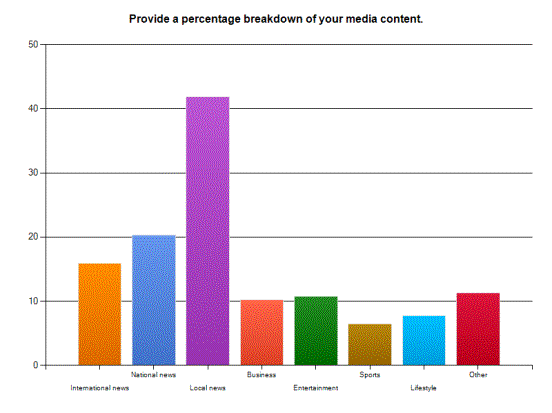
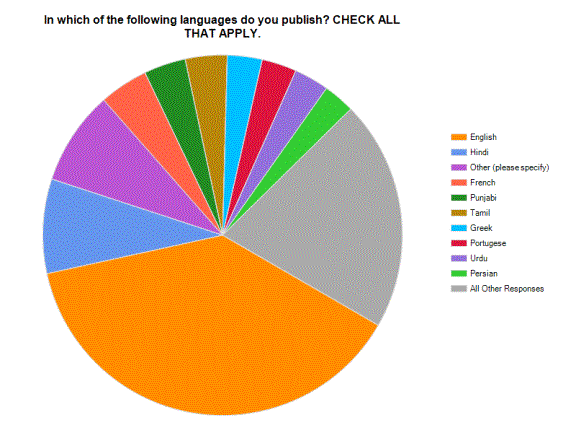
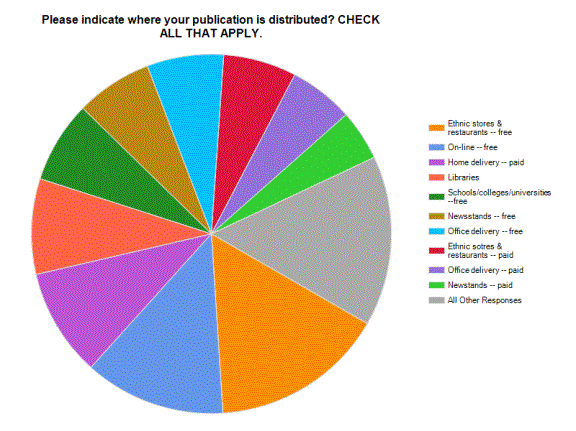
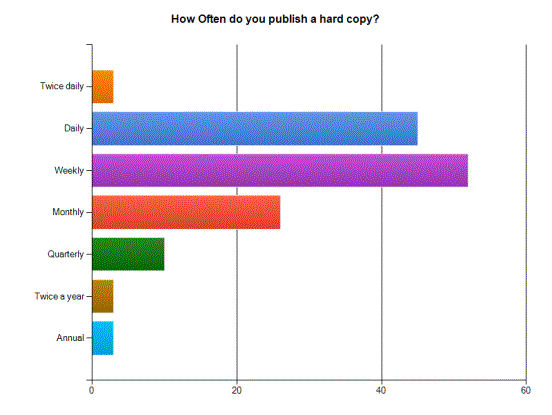
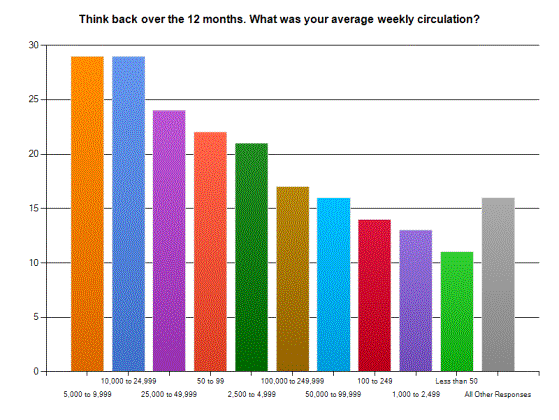
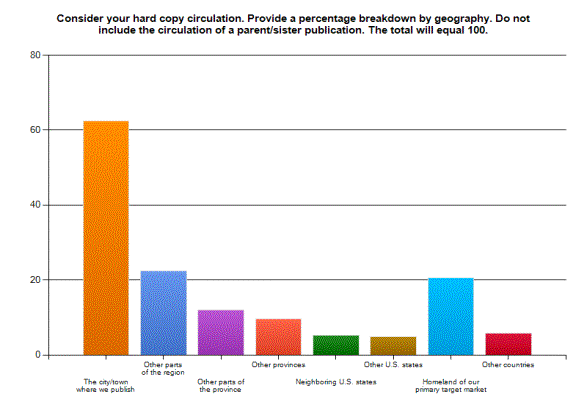
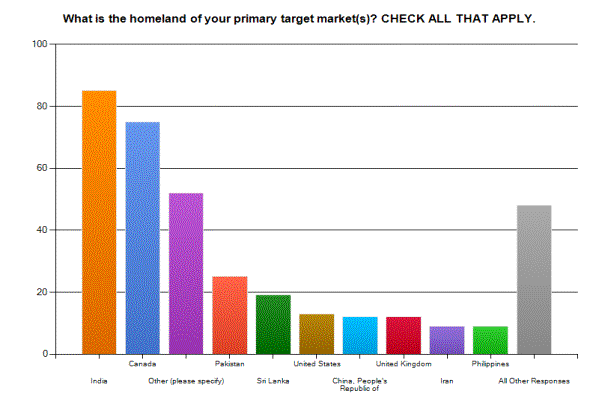

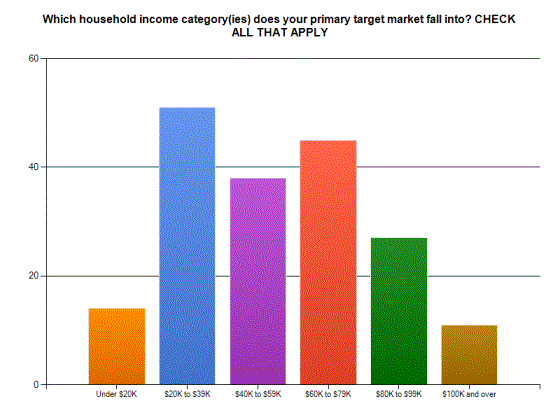
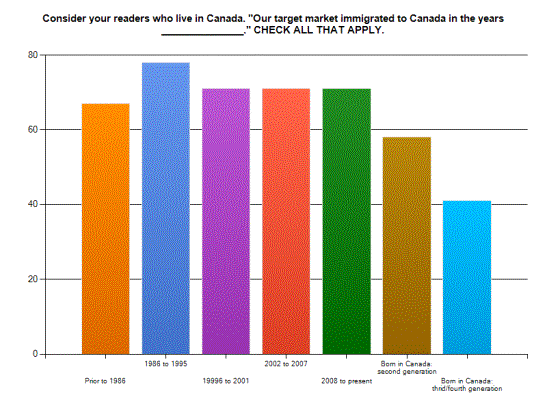
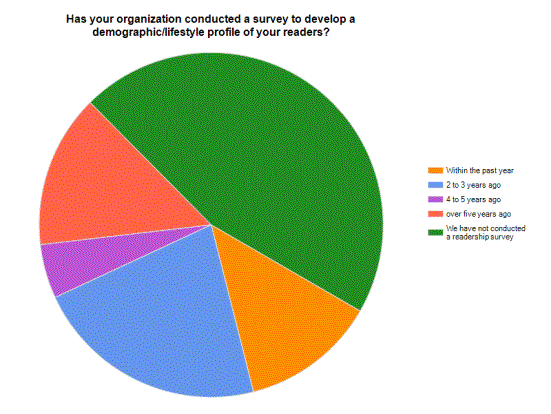

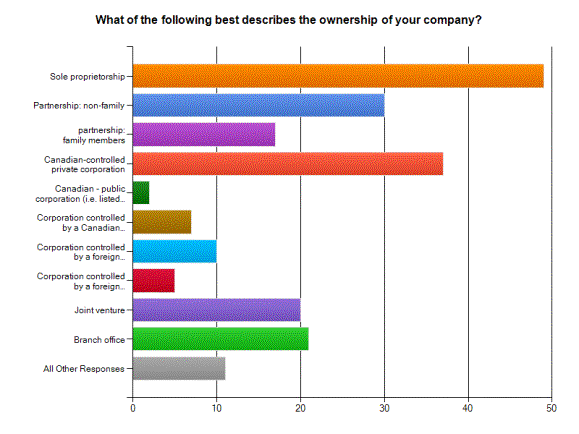
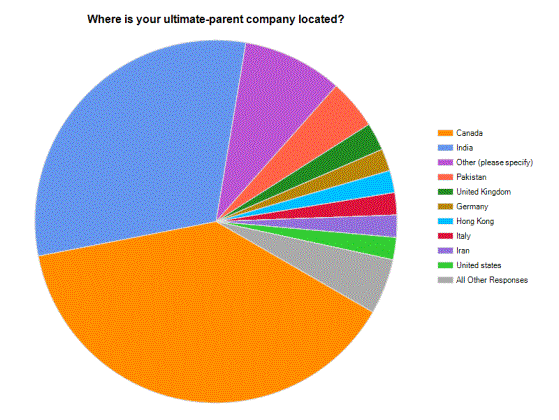
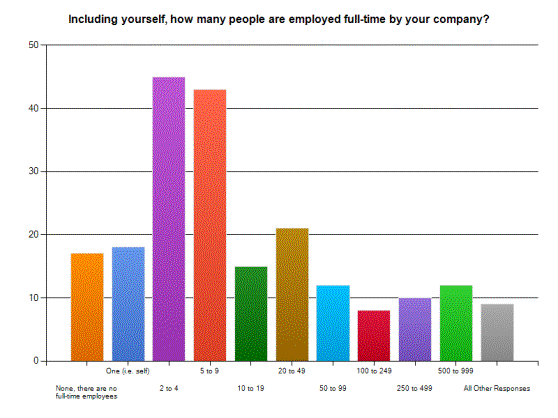
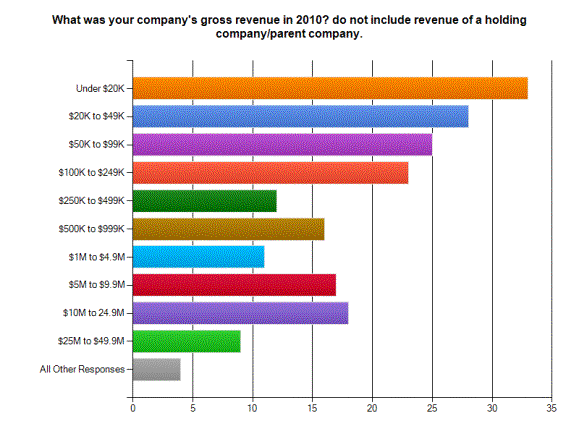
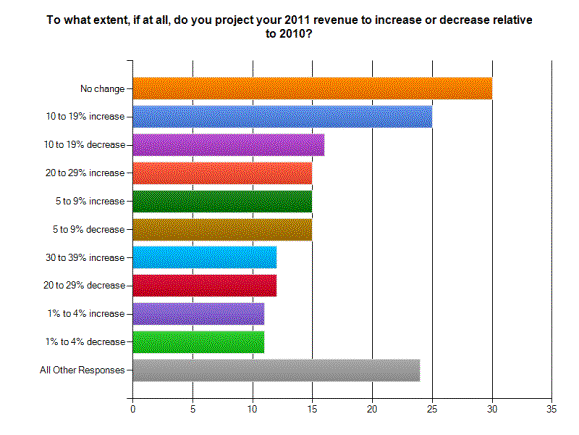
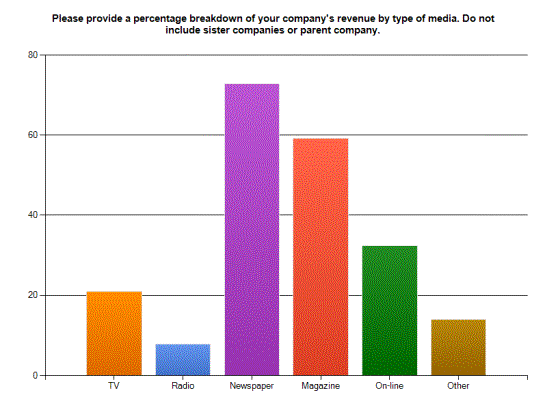
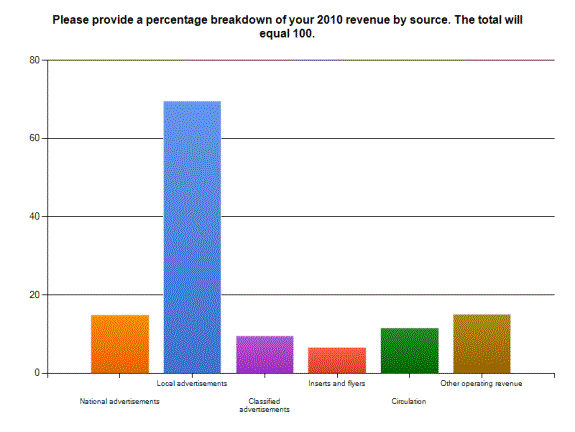
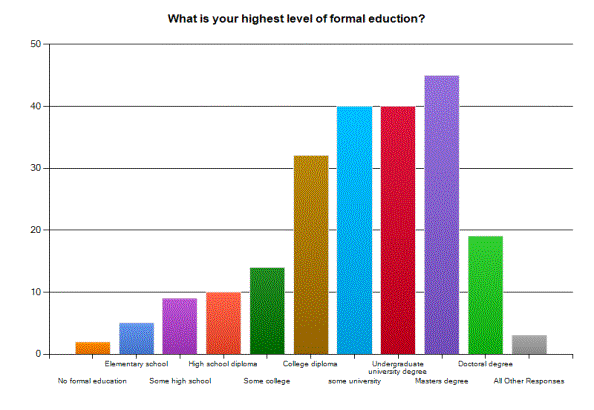
Survey
1
Introduction
Commencing in summer 2011 through September 30, 2011 members
of the National Ethnic Press and Media Council of Canada were surveyed.
Two hundred twenty-three members participated; over 40 per cent of the
association’s 530 members. Seneca College designed the survey
questions and analyzed the data.
1.1 Objective
The objective of the survey was to profile the Ethnic Media
industry in Canada:
1.
Business challenges
2.
Perceptions of the future
3.
Revenue size
4.
Sources of ad revenue
5.
Number of full-time employees
6.
Outsourcing
7.
Sources of content
8.
Distribution channels
9.
Target market
1.2 Method
The questionnaire was designed in collaboration with
Seneca’s School International Business. Telephone interviews were
conducted by representatives of the National Ethnic Press and Media
Council of Canada. Respondents had the option of completing the survey
on-line.
2
Key
Findings
2.1 Business Challenges
Let us first consider business challenges as they provide a
window to the industry.
2.1.1
Challenges: top-of-mind
At
the beginning of the survey, respondents were asked, “At present, what
is the biggest challenge faced by your organization?” (Appendix 1).
The
dominant theme was “financial resources”. Comments included:
•
“Not having enough financial resources to hire additional staff ... We
are also dealing with declining advertising support due to the economic
downturn.”
•
“We do not have enough resources to run and publish our monthly
newspaper.”
A
related theme was “advertising”:
•
“We have to compete for the same advertising dollars ... We do not
have the resources to market ourselves like the Star or the Sun, and a
result have very little scope to make publishing a profitable
venture.”
•
“Small publications who charge very little money, but claim huge
circulation make it hard for corporate Canada to trust ethnic media.”
A
lack of government funding was mentioned by several respondents and
there were several comments pertaining to changing technology and/or
readership:
•
“… a decline in readership due to mortality (post-war immigration
generation) and Internet availability for younger readers …”
•
“The biggest challenge is our readers could access news all over the
world ... The web takes away most of the newspaper business.”
2.1.2
Solutions: top-of-mind
Then,
respondents were asked, “How is your company addressing that business
challenge?” (Appendix 2).
Cost-cutting
measures were a common response:
•
“We have been managing because it is one of the oldest newspapers so
there is still some support from the business community. We also have to
cut many things to survive”
•
“Through a combination of borrowing ... and cutting back on expenses
… We are about to embark on direct solicitations to community members
to donate funds for the paper’s continuation.”
Many
respondents reported that they are pursuing advertising revenue:
•
“Trying to be innovative in terms of generating advertising revenue by
going online and joining [social networks].”
•
“Solicit ads from as many businesses as possible that advertise in
other media such as radio, television and other newspapers.”
Marketing-related
comments were common:
•
“Stay connected to our readership, so that they feel that they are the
voice of our community.”
•
“We are trying to get youth involved in community events so that they
will stay to their roots.”
Creative-thinking
describes several comments:
•
“We are having a more open concept in terms of our content so that we
sell our ads more easily.”
•
“Trying to be different [in our] approach, and giving the best
quality.”
Several
respondents commented on a strong work ethic:
•
“We have a strong passion to report news to our community, and we do
it regardless of losses.”
•
“Putting [in] extra hours and working for pennies”
One
ninth of respondents did not have a plan:
•
“We hold out for the day [for the] economic rebound.”
•
“Facing trouble addressing the issue.”
•
“We have very limited resources at our disposal, and can do very
little to address the situation.”
2.1.3
Internal issues: prompted
Respondents
assessed each of nine business issues. The respondents indicated that
“financing future growth” (37%) and/or “day-to-day financing”
(42%) was “insurmountable” or “very difficult”. “Attracting
advertisers” (46%), “retaining advertisers” (39%). “attracting
staff” (31%) and/or “retaining staff” (36%) were
“insurmountable” or “very difficult” to many respondents.
Relatively few saw “attracting readers” (9%) and/or “finding
interesting content to publish” (6%) as “insurmountable” or
“very difficult”.
2.1.4
External issues: prompted
Respondents
were asked to what extent, if at all, 13 external factors would impact
their revenue.
Nearly
64% perceived that an “upswing in the economy” would have a positive
impact. Conversely, 75% perceived that a “downturn in the economy”
would have a negative impact.
“Immigration
patterns” were seen as a good thing (positive: 50%, negative: 16%).
Perceptions of “second/third generation immigrants” (positive: 43%,
negative: 33%) were somewhat split.
Respondents
were split in their views of new consumer gadgets: Kindle/e-readers
(positive: 19%, negative: 21%) and iPad/tablet PCs (positive: 27%,
negative: 21%), and about the aging population (positive: 29%, negative:
32%). Perceptions of Facebook (positive: 46%, negative: 19%), Twitter
(positive: 36%, negative: 22%) and on-line news (positive: 42%,
negative: 32%) tended to be more positive than negative.
Mainstream media (positive: 21%, negative: 36%) was seen as less
positive than social media.
2.2
Expected changes in ethnic media
Next,
let us consider anticipated changes in the ethnic media industry.
The
following open-ended question was posed to respondents, “What changes,
if any, do you expect to see in the ethnic media industry within the
next three years?” (Appendix 3).
Some
comments were a wish rather than a prediction. “Survival of the
fittest” was a common response:
•
“Our target market can shrink because of online media outlets. With
limited resources, keeping up with this growing challenge is very
[imminent].”
•
“I don’t see any better hope. Our ethnic media will be dead if the
issue is not properly resolved.”
•
“More players, leading to M&As …”
Government
involvement was another common issue:
•
“We hope the government officials give the right business support to
ethnic media if it wants to keep the multiculturalism in Canada.”
•
“The so-called ‘ethnic media’ must be treated equally to the
mainstream media in receiving financial assistance from governments.”
Changing
demographics was perceived as a blow to some respondents and an
opportunity to others:
•
“As the current generation ages and dies, there will be less need for
ethnic media as the newer generations integrate more with the Canadian
community.”
•
“Ethnic media is a growing industry in terms of audience and with the
advancement of technology digital media is bound to grow in leaps and
bounds with the YouTube generation.”
Similarly,
the Internet was perceived either as an opportunity or an obstacle:
•
“It would be nice to make some money from having the newspaper on the
web, but I haven’t seen any way to do that yet ... People’s
willingness to pay a subscription to the paper has declined ...
successfully (till recently) been offsetting that loss in income with
advertising [to enable] readers to pick-up the paper for free.”
•
“More community newspapers will be online.”
A
few comments focused on industry growth:
•
“I expect that ethnic media will be more important in the next three
to five years.”
•
“The ethnic media will grow stronger and stronger. It will become the
new mainstream media.”
2.3
Company profile
This
section of the report considers the make-up of businesses in the ethnic
media industry. We will consider business ownership, location, revenue,
senior executives, staff, expense type and whether succession plans are
in place.
2.3.1
Business Ownership
Respondents
were asked, “Which of the following best describes the ownership of
your company?”
The
most common business types were “a Canadian-controlled private
corporation” (18%) and “sole proprietorship” (23%). Partnerships
accounted for one fifth of responses (non-family: 14%, family members:
8%). 3% reported “corporation controlled by a Canadian corporation”.
One respondent stated “Canadian – public corporation”. “Joint
venture was almost ten percent (9.6%). “Other” responses were
“community” and “society” (1%).
As
a cross-check, respondents were asked, “Is your company owned by
another company?” 0.4% answered “yes”; however, 24% “don’t
know”.
2.3.2
Business Location
2.3.2.1
Office Space
25%
of respondents reported that they “work from home”. 30% used
“serviced office space (i.e. receptionist, fax machine)”, 23% a
“virtual office”, 30% “Commercial office space” and 1.4%.
2.3.2.2
Geography
Respondents
were asked, “What is the primary location of your business?”. They were presented with a list of 32 city centres. Some
people gave more than one response. “Toronto” topped the list at
32%, “Vancouver” (7%) and “Montreal” (5%) were a distant second
and third. “Calgary” (3%) and “Edmonton” (2%) were fourth and
fifth.
2.3.3
Business Formation
The
data suggest that business formation was fairly uniform over time.
Nearly 18% were formed “2008 to present”, 34% reported that their
business was formed in “2002 to 2007”, 16% were formed “prior to
1986” (1986 to 1995: 13%, 1996 to 2011: 19%).
2.3.4
Business Size
2.3.4.1
Gross revenue
In
2010, 62% companies had gross revenue of less than $500,000, according
to respondents. 31% of
respondents reported gross revenue of less than $50,000. 3% exceeded
Canada’s definition of a small business; they reported at least $5
million in gross revenue.
In
addition, respondents were asked, “To what extent, if at all, did your
2010 revenue increase or decrease relative to 2009?”. 33% reported at
least some increase; 16% reported an increase of at least 20 %. 29%
reported a decrease in revenue. 8% of respondents reported a decrease of
least 20 %. 38% reported no
change.
They
were also asked, “To what extent, if at all, do you project you 2011
revenue to increase or decrease relative to 2010?” 43% projected at
least some increase; 17 % anticipated an increase of at least 20 %. 26%
expected a decrease in revenue; 1% anticipated a decrease of least 20 %.
31% expected no change.
Then,
they were asked, “Why do you expect to see this change in revenue?”
(Appendix
4).
Comments
of those expecting at least a 25 % increase included:
•
“If I get the support from the Canadian Periodical Fund to help the
magazine with printer costs ... I would probably hire an employee to the
sales department to help me grow the sales.”
•
“We improved our magazine.”
Among
those who expected no change in revenue, comments included:
•
“Because we do not have funding or strong support ... to make anything
better …”
•
“Increasing competition for advertising revenue from the big players
like Rogers and Toronto Star, and steady decline in government
advertising revenue.”
Comments
of those expecting a slight decrease included:
•
“More competition and aggressive expansion of the mainstream media
….”
•
“Because the economy is still [in a] slowdown …”
2.3.4.2
Revenue by type of
media
Respondents
were asked to breakdown their revenue by type of media.
“Newspaper”
(73% average) ranked first. “Magazine” was second (59%). On-line was
third (37%); data entries suggest that some respondents separate on-line
revenue from their total revenue. “TV” (21%) and “radio” (8%)
ranked third and fourth respectively.
-
Seven tenths (71%) reported that at least some revenue was
generated by “newspaper”.
-
One quarter (25%) generated at least some revenue from
“magazine”.
-
Over one third (36%) cited “on-line” revenue.
-
One tenth listed some “TV” (10%) and or “radio”
(10%).
- Seven
percent (7%) included “other”.
2.3.4.3
Revenue by type of
ad & other streams
In
addition, respondents were asked to breakdown their revenue by source.
“Local advertisements” (70% average) accounted for the largest
portion of revenue. “National advertisements” (15%) and “Other
operating revenue” (15%) ranked second followed by “Circulation”
(11%). “Inserts and flyers” (7%) was the lowest revenue generator,
on average.
•
The 80th percentile for “national advertisements” was 21 %. That is,
eight tenths of respondents reported that 21 percent or less of their
revenue was derived from national advertisements.
•
The 80th percentiles for “circulation” and “classified
advertisements” were both 10%.
•
The 80th percentile for “local advertisements” was 90 %.
•
“”Inserts and flyers” had an 80th percentile or three %.
2.3.4.4
Local ad revenue by
ethnicity
Respondents
were asked, “Consider local advertisements. What percentage of local
ad revenue, in 2010, came from businesses or organizations controlled by
each of the following ethnic categories?”. “Our ethnic target
group” (57% average) ranked first. “Majority group” (28%) was
second, “Another minority ethnic group” (16%) was third.
•
The 80th percentile for “our ethnic target group” was 100 per cent.
That is, eight-tenths of respondents reported that all of their local ad
revenue was derived from businesses/organizations controlled by members
of the primary target market.
•
The 80th percentile for “majority group” was 34 %.
•
“Another minority group” had an 80th percentile of 10 %.
2.3.5
Employees
2.3.5.1
Number of employees
“Including
yourself, how many people are employed full-time by your company?”
The
vast majority (93%) reported nine or fewer full-time employees. 17% have
no full-time person, 20% have one, 16% have two to four, and 21% have
five to nine.
2.3.5.2
Change in the number
of employees
Respondents
were asked, “To what extent, if at all, has the number of full-time
employees increased or decreased from the previous 12 months?”. 32%
reported “no change”. 40% indicated a reduction in the number of
employees. 28% reported an increase.
Then,
respondents were asked, “To what extent, if at all, do you expect the
number of full-time employees to increase or decrease within the next 12
months?”. Employment gain, as compared to preceding 12 months,
increased to 30 %; “no change” (30%) was in equal proportion. 13%
expected loss to remain constant. Then they were asked, “Why do you
expect to see this change in full-time staff?”
Comments
of those who expect an increase in staff included (Appendix 5):
•
“We expect to grow and hire more staff.”
•
“Expand the company.”
Comments
of those expecting no change in staff included:
•
“[It’s] Difficult to attract full-time staff due to the pay package.
Once they get experience, they would like to move to a better
job/career.”
•
“More revenue by ads [is] required to change this.”
A
respondent who expected a slight decrease in staff commented:
•
“More tightened conditions to operate …”
2.3.5.3
Outsourcing
Respondents
were presented with a list of eight job functions: “writing”,
“editing”, “sales and marketing”, “distribution”,
“legal”, “accounting” and “office administration”. For each
job function, they estimated the proportion of work that is outsourced.
The vast majority (87%) reported that they outsourced.
The
proportion of organizations that outsourced at least some of a given job
function was: writing (88%), editing (75%), distribution (67%),
production (51%), sales and marketing (75%), accounting (31%), legal
(28%) and office administration (33%).
Let
us consider the incidence of at least 50 % of a given function being
outsourced: distribution (23% of organizations), writing (20%),
accounting (19%), production (16%), legal (14%), editing (12%), sales
and marketing (12%) and office administration (6%).
2.3.6
Senior Executives
2.3.6.1
Ultimate
Decision-Maker
Respondents
were asked, “Who is the ultimate business-decision maker in your
company?” 40% stated “publisher”. “Editor” was a distant
second (24%). “Other” responses were “director/board of
directors” (4%), “president” (2%), “me” (1%) and “executive
producer” (1%).
2.3.6.2
Age: Senior
Executives
Respondents
provided the age category of their organization’s youngest and oldest
executive. On average, the oldest executive was 53 years old. 42% of
organizations, the oldest executive is 55 years of age or older. Only 4%
reported that their oldest executive was less than 35 years of age.
The
average age of the youngest executive was 37. In 44% of organizations,
the youngest executive is under the age 35. 8% reported 55 years of age
or older.
2.3.6.3
Succession Planning
Given
that the risk of morbidity and mortality increases with age, respondents
were asked, “Does your company have a succession plan in the event
that a senior executive falls ill, passes away or leaves the company?”
Balance is noted between “no plan” (38%) and “an informal plan”
(41%). 20% had a “written plan”.
2.3.6.4
Ethnicity: Senior
Executives
Respondents
indicated the percentage of senior executives in each of three ethnic
categories. Across organizations the mix was “our ethnic target
group” (67% average), “majority
group” (40%), “another ethnic minority group” (31%).
•
The 40th percentile for “our own ethnic target group” was 86. That
is, four tenths of organizations had “our ethnic target group”
represented by 86 percent or less senior executives. The 50th percentile
was 100.
2.3.7
Expenses
Respondents
were asked to breakdown expenses into eleven categories. “Product
production” accounted for over one-fifth (22% average) of total
expenses. “Payroll” accounted for one 67% of expenses.
“Rent” (44%), “product distribution” (26%), and
“automobile” (8%) ranked third, fourth and fifth, respectively.
“Marketing” (6%) and “utilities” (5%) were sixth and seventh.
“Out-of-town transportation” (2%) and “business entertainment”
(2%) and “hotel” (1%) were minimal, overall. “Other” was six
percent (6%) on average.
•
The 80th percentile for “marketing” was 10 percent. That is, three
quarters of respondents reported that marketing accounts for 10 percent
or less of total expenses.
•
The 80th percentiles for “payroll”, “product production” and
“product distribution” and “rent” were 39 percent, 44 percent,
18 percent and 18 percent, respectively.
2.4
Publication Content
Let
us now consider media content, as reported by respondents.
2.4.1
Sources of Content
Respondents
estimated percentage breakdown of content obtained from Canadian and
international sources. Across respondents, 63 % of content is derived
from Canadian sources.
•
The median for Canadian sources was 70 %.
•
The 75th and 90th percentiles were 80 % and 90 %, respectively.
2.4.2
Type of Content
In
addition, respondents provided a breakdown of their publication’s
content. In general, content is evenly distributed across “local
news” (average: 42%). “national news” (20%) and “international
news” (16%). “Entertainment” accounts for 10%. “Business”,
sports” and “lifestyle” each comprise about 5% of a publication.
“Other” content was 7 %.
•
The 75th percentiles for “local news”, “national news” and
“international news” were 30 percent, 29 percent and 25 percent,
respectively.
2.4.3
Language
Respondents
were asked, “In which of the following languages do you publish?”
Respondents could select more than one language. “English” (52%) was
the top response followed by Hindi (12%). French ranked third (6%).
however Greek, Persian, Tamil and Urdu each ranked at 5% for a 20%
representation Persian (6%) ranked third and fourth, respectively.
“Urdu” was listed by five percent (5%) of respondents. Other
languages were cited by less 12% of respondents. Five of the 11
respondents who selected “French” were from Montreal. Three were
from Vancouver. Two were from the Greater Toronto Area. The other
respondent was from Calgary.
2.5
Distribution
The
vast majority reported that they had an average weekly circulation,
within the past 12 months, of 1,000 to 50,000. Over half (56%) had less
than 10,000.
Under
1,000 36%
1,000
to 2,499 6%
5,000
to 9,999 14%
10,000
to 24,999 14%
25,000
to 49,999 11%
50,000
& over 19%
2.5.1
Distribution channels
Respondents
were asked where their publication is distributed. “On-line, free”
(34%) was much more likely than “on-line, paid” (8%). “Ethnic
stores and restaurants, free” (42%) was ranked higher than “ethnic
stores and restaurants, paid” (18%). “Newsstand, free” (19%) was
less than “newsstand, paid” (26%). “Office delivery, free” (19%)
was less likely than “office delivery, paid”(26%). “Home delivery,
free” (19%) was less than “home delivery, paid” (26%).
“Libraries” (23%) and “schools/colleges/universities, free”
(20%) were balanced. Hotels were least often cited (hotel convenience
store, free: 10%, hotel convenience store, paid: 5%, guest room: (7%).
2.5.2
Distribution method
In
addition, respondents were asked how hard copies are distributed; they
could give more than one response. Less than half reported that the
delivery to “stores and/or restaurants” (43%) and/or to “homes
and/or office” (44%) was organized in-house. 28% used “a
distribution company to bundle and ship to stores and/or restaurants”
16% used “a distribution company for home and/or office delivery”.
Two
respondents reported that their publication has only electronic
distribution. Three respondents indicated that they work in radio or
television. One respondent’s “other” response suggests freelance
photography.
•
8% reported that home/office delivery was both prepared in-house and
used a distribution company.
•
11% reported that store/restaurant delivery was both prepared in-house
and used a distribution company.
2.5.3
Market area
In
terms of geographical distribution, two-thirds (average: 65%) cited
“the city/town where we publish”.
“Other parts of the region” (22%), “other parts of the
province” (12%) and “other provinces” (9%) ranked a distant
second, third and fourth. One-tenth was accounted by the United States (neighbouring
states: 5%, other states: 5%), with “homeland of our primary target
market” at 21% and “other countries” at 6%.
2.6
Consumer Profile
Let
us now consider the consumer of ethnic media, as perceived by
respondents.
2.6.1
Readership Survey
Over
half (54%) of respondents reported that their organization surveyed and
profiled their readers within the past three years. 46% reported that
their organization had never conducted a readership survey.
2.6.2
Demographic profile: consumer
80%
respondents reported that they target both males and females.
People
“under 18 years of age” (11%). “18
to 24 year olds” (44%) and those aged “75 or older” (22%) were
less likely than other groups to be targeted. Nearly 17% selected only
one age group. “45 to 54” (44%) was the most frequent single-cohort
response.
In
terms of household income, “$20 to $39K” was targeted by 81% of
those respondents who answered the question. Over half of respondents
targeted income groups over $40,000. 10% targeted households earning
under $20,000. Given the low participation in this question, one might
conclude that income is not a critical variable in marketing their
product.
Respondents
were just as likely to target people who came to Canada “prior to
1986” (57%) as “2008 to present” (61%). In general, respondents
cited “third/fourth generation” less often (35%) than other
immigrant groups.
•
10% focused on immigrants who have been in Canada 10 years or more.
•
Only one focused on new immigrants and those born in Canada.
Respondents
were asked, “What is the mother tongue of your primary target
market?”; they could select more than one language. “English”
(43%) was the top response; this finding was consistent with an on-line
list of languages spoken in each country represented in this survey (www.infoplease.com).
Asian
languages captured the next six spots; this reflects that two fifths of
survey respondents reported that they were born in Asia. “Urdu”
(11%) ranked second. “Tamil” (9%) and “Hindi” were third and
fourth. “Cantonese” (4%),“Mandarin” (4%)
and“Tagalog” (4%) tied.
2.6.3
Catalyst to read
An
ethnic publication will experience natural attrition in its readership
base due to mortality, and possibly due to the assimilation of second
and third generation immigrants into mainstream society. While new
readers are required, a commonly held belief in society is that the
younger generation is much less interested in reading than their elders.
Hence,
respondents were asked, “From your perspective. How can young adults
be enticed to read” (Appendix 6).
The
most frequent suggestion was relevant content:
•
“Articles about them or their peers ….”
•
“Give them what the mainstream media is giving them ... do care about
what is happening back home, nor do they read in their mother tongue.
They are not our market, but we need them in order to keep refilling
readers who pass on.”
•
“Give space in the magazine, and let them be in-charge of that
particular page.”
A
common suggestion was “English” content:
•
“Young readers read the paper if we publish in English and topics
related to their problems.”
•
“Showcase all materials in English.”
Other
content-related comments included:
•
“Strong articles and unbiased reporting …”
•
“By making it positive and fun; but also providing serious information
without discretion and censorship because everyone likes to know what is
going on in their world …”
A
few respondents reflected on cultural and family influences:
•
“[It] starts at home with the reading of books.”
•
“People who are connected with their culture read our publication from
cover to cover.”
Social
media was also mentioned:
•
Social media updates with cross-reference to [the] web site is
important. Also reaching out with issues and items directly related to
their lifestyle.”
•
“Create a web site for our publication ... attract young adults [with
interactive tools] such as ESL [English as a second language] ... could
find interesting stuff in our weekly on-line newspaper so advertisers
would like to put more ads.”
2.7
Respondent Profile
Earlier,
we examined senior executives and staff. Let us now consider the survey
respondents. In many instances, the respondent is the company as he or
she is a sole proprietor.
2.7.1
Job title
Respondents
were asked, “What is your job title? If you have more than one role,
select up to three that most apply”. 60% provided more than one job
title. 26% listed “publisher”. 19% listed “editor” and/or
“owner” (19%). “Senior editor” (19%), “journalist” (12%),
“photographer” (9%) each accounted for other multiple job title
responses.
2.7.2
Age
38%
reported that they are 35 to 64 years old, 35 to 44: 20%, 45 to 54: 18%,
55 to 64: 10%); the average age was 52. 8% were 65 years of age or
older. 24% were 25 to 34. Nobody was under the age 25.
2.7.3
Entry to Canada
Only
3% of respondents were born in Canada. 14.2% immigrated within the past
10 years. Among those who have been in Canada 10 years or more, the
group “prior to 1986” (32%) was a bit larger than “1986 to 1996”
(25%) and “1996 to “2001” (24%).
Then
respondents were asked, “Which of the following best describes your
landing status when you arrived in Canada?” “Economic class, skilled
worker” (37%) ranked first; it was followed by “family class,
sponsored by a family member” (21%), “refugee” (14%) and
“student” (2%). “Other” (11%) included the old term of “landed
immigrant” (3%), as well as “political asylum”, “working
permit” and “ordinary immigrant”.
2.7.4
Birthplace
Respondents
provided the country of their birth. The data were summarized according
to the United Nations Country Grouping. Asia (44%) ranked first. EU
(17%) was second; other parts of Europe were an additional six percent
(6%). Middle East was third (13%). East Africa (8%) was fourth. Canada
was six percent (6%). South America (3%). Caribbean (2%) and Central
America (1%) comprised the remainder of the sample.
2.7.5
Household Size & Composition
The
average household size was 3.4. 25% reported “two (me and one other
person)”. Three and four-person households were reported by 30% and
20% of respondents respectively. 13% reported that they “live
alone”. One-fifth reported households consisting of five or more
people.
In
addition, respondents were asked about their relationship to other
members of their household. Less than half (44%) listed “my spouse”.
23% included “my children under the age 18”. 25% included “my
grown unmarried children 18 years of age or older”. 25%) included
“my parents”. “My grown married child and their spouse” and/or
“my grown unmarried brother/sister” was listed by 4%. Other
relationships were each mentioned by 2% or less.
2.7.6
Education: Respondent
66%
reported that they have completed at least one university degree; this
is significantly higher than the 2006 national figure (24%) generated by
Statistics Canada. 15% were less likely than the national (25%) to hold
a college diploma. Only 2% reported high school or less (national: 48%).
2.7.7
Personal Income: Respondent
2.7.7.1
Employment Income:
Personal
Respondents
were asked to report their 2010 personal employment income from all
sources, excluding investments and government subsidies, before taxes.
20% reported personal employment income of $60,000 or more; there is no
significant difference with the 2009 national estimate by Statistics
Canada (20%). The proportion of respondents who reported less than
$20,000 (22%) was significantly less than the 2009 national figure
(40%).
2.7.7.2 Employment Income: Household
In
addition, respondents were asked to report 2010 employment income before
taxes that was generated by all members of their household. There was no
significant difference in the proportion of respondents in each income
category relative to the 2009 national estimate by Statistics Canada.
2.7.7.3 Employment income from ethnic media
In
addition, respondents were asked what portion of their 2010 personal
employment income was generated by their job in ethnic media. 43%
reported that they “do not earn money from my work in ethnic media”.
One quarter reported 75 percent or more of their employment income is
generated through their work in ethnic media (75 to 99: 14%, 100: 12%).
The average was 19%.
2.7.7.4 Other Paid Employment
Respondents
were asked, “Aside from your work in ethnic media, what other paid
jobs do you currently have to earn an income?” 27% reported “I do
not have any other paid jobs”. 11% were in “sales”; an additional
13% listed sales-related jobs under “other” (e.g. insurance, real
estate, mortgage agent). “Skilled labourer” accounted for 8%.
Professionals such as doctors and teachers comprised another 16%.
“Other” responses included “investor”, “property manager”
“school bus driver”, “pensioner”, “translator”, “journal
editor”, “business consultant”, “office worker”, “health
care worker”, “restaurant owner”, “dance school operator” and
“artist”.
3
Recommendations
The
findings of this research lead to several recommendations:
• Provide members with training in business management, marketing,
creative problem-solving, leadership and succession planning.
-
The data suggest that many members do not have a formal plan
to operate, develop and sustain their business.
-
And, there is no plan to replace the current leader(s) in the
event morbidity or mortality.
•
Look for synergy with other members.
-
Half of respondents indicated that their organization had
never conducted a reader/viewer
survey.
-
To understand perceptions and attitudes of current and
potential users, focus groups
and a quantitative survey should be developed and implemented. The same
questionnaire should be used by all member-organizations, and data should be analyzed by the same research team to ensure consistency.
-
Given that many members operate very small business and the
importance of ethnic media to
Canada, the survey should be funded by government or corporate sponsor(s).
•
Widen revenue bases.
-
The base of advertisers could be widened to the larger local
community and to national advertisers by pooling salesperson-resources
to sell ad space in multiple publications simultaneously, “Your ad
will reach XXX,000 consumers of ethnic media”.
-
A model would need to be developed, to include sales
incentives, key message to attract potential advertisers and revenue
sharing.
-
Likewise, some other job functions and resources could be
pooled. e.g. Securing lower prices at a print shop by using split-runs
to print more than one publication (i.e. economies of scale across
distribution, web site design)
•
Establish interactive forums for members to share best practices.
-
For example, some members perceived social media as an
opportunity whereas others saw it as the death knell.
-
At least twice a year, members should assemble for
brainstorming sessions to generate ideas and to establish a common set
of plans.
•
Look for ways to capture the attention of young adults.
-
As existing consumers of ethnic media grow old and die, their
children and grandchild are
needed to sustain the media outlet.
-
Run focus groups, with young adults representing different
ethnic groups, to generate ideas.
-
Work with journalism schools to bring in young writers –
provide them with a financial incentive to continue working with the
publication after graduation.
-
Work with the ESL departments of colleges to expose newcomers
to the media source.
Many
respondents commented that they lack financial resources. Training
programs and synergy, as suggested above, will go a long way to
streamline process.
Still,
government subsidies are required to fill the gaps.
To
paraphrase one respondent, ‘ethnic media is the voice of Canada’.

Canadian Discussions
Community
Through this report the influences of globalization and
diaspora on Canadian immigration, settlement and culture have been
observed. The emergence of new multicultural, multilingual Canadian
television channels and digital media make an expanded world of
interactive intercultural communication horizons and access available to
most Canadians. Recent Canadian and international ethnic media studies
have been reviewed to better position thought on the NEPMCC study.
But what does the Canadian public think about our third
language media? What are the public’s third language readership and
viewership preferences? Are those preferences determined by and do they
differ across demographics such as age? Do Canadians who do not speak or
understand a third language have opinions about Canada’s third
language media? If so, what are those opinions?
During December 2011 the author conducted independent mall
and street surveys in the Greater Toronto Area (GTA) and surrounding
area to survey Canadian residents and citizens about their third
language media habits and impressions.
Ten interview locations were drawn randomly out of a possible
pool of thirty locations that represent a sampling of concentrations of
Canada’s cultural and third language diversity.
15 young adults (ages 18-25) and 15 mature adults (age 40+)
who speak or understand a third language were surveyed at each location.
The random survey locations and cultural diversity
concentration representations are:
|
Location
|
Cultural
Diversity Concentration Representation |
|
Danforth
Ave. & Logan Ave.
|
Greek |
|
Dundas
St. W. & Ossington Ave.
|
Portuguese
|
|
Eglinton
West
|
West
Indian |
|
Gerrard
St. East & Greenwood Ave.
|
Afghan,
Bangladeshi, Indian, Pakistani |
|
Lawrence
Plaza
|
Jewish |
|
Pacific
Mall
|
Asian
and South-East Asian |
|
Roncesvalles
Village
|
Polish |
|
Sherway
Gardens Mall
|
Mixed
|
|
Woodbridge
Mall
|
Italian |
|
Yonge
St. north of Finch Ave.
|
Iranian |
Survey
questions were the same for all locations and both age groups. They are:
1.
Do you speak and/or understand a third language?
This means a language other than English and French, Canada’s
official languages.
If
the respondent answered ‘yes’ they were asked to respond to
questions 2 through 17.
If
the respondent answered ‘no’, they were asked the question, “Do
you have any observations on or comments about the importance of
Canada’s third language media?”
2.
Do you read Canadian newspapers, magazines and/or periodicals in a third
language?
3.
On a scale of 1-5, 1 being not important and 5 being very important rank
the importance of third language Canadian newspapers, magazines and
periodicals to you and your life in Canada.
4.
On a scale of 1-5, 1 being not important and 5 being very important rank
the importance of third language Canadian newspapers, magazines and
periodicals to your culture.
5.
Do you listen to Canadian radio in a third language?
6.
On a scale of 1-5, 1 being not important and 5 being very important rank
the importance of third language Canadian radio to you and your life in
Canada.
7.
On a scale of 1-5, 1 being not important and 5 being very important rank
the importance of third language Canadian radio to your culture.
8.
Do you watch Canadian television broadcasted in a third language?
9.
On a scale of 1-5, 1 being not important and 5 being very important rank
the importance of third language Canadian television broadcasting to you
and your life in Canada.
10.
On a scale of 1-5. 1 being not important and 5 being very
important rank the importance of third language Canadian television
broadcasting to your culture.
11.
Do you use the Internet, and/or social media, and/or texting in a
third language?
12.
On a scale of 1-5, 1 being not important and 5 being very
important rank the importance of third language Internet, and/or social
media, and/or texting to you and your life in Canada?
13.
On a scale of 1-5, 1 being not important and 5 being very
important rank the importance of third language Internet, and/or social
media, and/or texting to your culture.
14.
In order of preference, 1 being highest and 4 being lowest, rank
your personal Canadian third language media preferences; newspapers,
magazines and periodicals as one group, radio, television and the
Internet, social media and texting as one group. If you have two or more
media that you prefer equally you can rank them the together.
15.
Which Canadian third language medium is most important to you for
your source of news in your homeland?
16.
Which Canadian third language medium is most important to you for
your source of information for news in Canada?
17.
Which Canadian third language medium is most important to you for
information about life and living in Canada, Canadian culture,
immigration, politics and community programs?
The
survey findings show that location geography and predominant ethnicity
at that location were not significant factors in a respondent’s
willingness to disclose their age group or participate in the survey.
The
subject of Canadian third language media was of very strong interest to
over 89% of those surveyed. The degree of English comprehension did vary
geographically, being lower in those locations where heavy Canadian
immigrant traffic was present and higher in those locations with mixed
ethnicity present.
523
respondents were surveyed. 300 or over 57% either spoke and/or
understood a third language.
Of
the 223 respondents that did not speak and/or understand a third
language, the distribution was highest at the Eglinton West and Sherway
Gardens locations. Of this group 168 or over 75% volunteered
observations and/or comments on the importance of Canada’s third
language media.
140
respondents or over 83% stated that third language media is either
important or very important to Canadian culture and identity. 38
respondents observed that third language media is emerging as the
mainstream or dominant media in Canada. Only eight respondents or 1.53%
of total respondents declined to comment. There were zero negative
comments or observations.
Of
note are the following respondents’ observations from the group who
did not speak or understand a third language;
“Our
family is finally learning Italian. We sit with Nona
(grandmother) and watch CHIN-TV. They have one commentator in
Italian and one in English discussing the topic together. That way we
learn Italian and my grandmother can practise her English. We do it all
together. It brings the generations closer together and preserves our
culture.”
“I
picked up the Chinese newspaper and got the best deal on a flight to
Beijing. I couldn’t read
the language but the price was obvious. I couldn’t have gotten that
price anywhere else.”
“I
love the Bollywood movies on OMNI. I’m learning how to do the dances
and went to an Indian sari store that was advertising on the channel to
buy an outfit. The people there were so nice and we’ve become great
friends.”
“Canada’s
third language media help me to understand our newcomers and to be a
better Canadian.”
Following
are the results from the 300 respondents that completed the full survey.
Although the survey is a random urban sampling limited by its size,
survey questions and focus on two demographic groups (18-25 and 40+) it
does establish the need for deeper more comprehensive national research
in support of third language speaking Canadians and the ethnic media
that serve this audience.
150
respondents were age 18-25; 60% female, 40% male. At the ‘5’ or very
important level this group demonstrated an averaged 39% third language
Internet/social networking/texting media preference with little if any
media preference differences between female and male respondents.
Television (32%). radio (20%) and newspapers/magazines/periodicals (9%)
ranked 2nd, 3rd and 4th in their media
preferences. Asian, Indian and Jewish males demonstrated a marginal
preference over other groups for newspapers/magazines/periodicals.
Canadian content in the Internet/social networking/texting medium was
not determined.
This
category may also contain content that is categorized Internet radio
which would be reflected in a lower preference in the traditional radio
media category. Consistently across all groups third language Canadian
newspapers/magazines/periodicals were ranked important to very important
to the respondents’ lives in Canada and their respective culture but
not ranked highest as their medium of preference.
Contributing
factors to this difference may include the immediacy and interactivity
of digital media and readership of online third language newspapers by
this demographic group. Canadian third language radio and television
broadcasting media were both ranked very high in importance to culture
but only moderate to moderate-high to self and life in Canada.
From
a Canadian intercultural social integration perspective the global
nature of Internet/social networking/texting media sources for this
demographic group may reinforce homeland identification while creating
excessive competition for Canadian third language media. Canadian third
language television was ranked most important for both homeland and
Canadian news.
Canadian
third language newspapers specifically were ranked most important to
this young adult group for information about life and living in Canada,
Canadian culture, immigration, politics and community programs.
Correlating
this survey’s findings on the 18-25 demographic group with the NEPMCC
Survey recommendations it is important that Canada’s ethnic press in
particular and third language media in general find innovative and
sustainable ways and the necessary support required to attract and
communicate with this dynamic globalized audience of Canadians.
As
one respondent suggested, “Why don’t you put your survey up on
Facebook and go viral?” The suggestion had certain merit, but the main
advantage to conducting a survey in person is the great opportunity to
establish face to face communication within the context of building
Canadian communities.
The
150 age 40+ respondents surveyed were 68% female and 32% male. As one
respondent stated, “My husband is at home reading the Chinese
newspaper while he waits for the Taiwanese news broadcast on TV.”
This survey demographic collectively ranked Canadian third
language newspapers/magazines/periodicals and Canadian third language
television broadcasting at ‘5’, very important in terms of their
lives in Canada and their culture with a score of 36% and 36%
respectively for each medium. Canadian third language radio followed at
20% and the Internet/social networking/texting at 8% as being very
important.
Several
respondents commented that they are using the Internet daily and started
social networking and texting over the past 18 months. Canadian third
language newspapers specifically and television were ranked most
important regarding homeland news. Canadian third language radio and
television broadcasting were ranked highest in importance as the media
of choice for news about Canada. 87% of the survey group ranked Canadian
third language newspapers, magazines and periodicals ‘5’ or most
important for information about life and living in Canada, Canadian
culture, immigration, politics and community programs.
Of
the 150 respondents in this group 78 made comments either after
individual survey questions the or following the survey. Multiple
comments of a similar nature and to paraphrase include;
“We
need more free newspapers in our language.”
“Our
third language newspaper is how I find out about Canada and how to be a
good Canadian.”
“Canadian
third language media let me know where our community events are.”
“I
also watch some of the other programs in different languages. It brings
all of us newcomers together as Canadians.”
“We
need more TV programming in my own language with a crawl in English on
the screen so I can learn English better.”
“Newspapers
and TV in my language have homeland news stories that are not carried in
the English media. This way Canada can find out about issues abroad like
politics and social injustice elsewhere in the world.”
“This
is how my children and grandchildren keep our culture and language
alive.”
“Canada’s
third language media is who we are as Canadians. It is all of the
aspects of us all together as Canadians. We need more.”
While
the above are highlights from the December 2011 GTA mall and street
surveys of two different demographic age groups, both those who use
Canadian third language media and those who do not speak or understand a
third language resonate with a clear, consistent voice.
In
summary:
-
Canadian third language media are a central, necessary part of Canadian
being, community, identity, culture and intercultural understanding.
-
Canadian third language press and particularly Canadian third language
newspapers are the trusted media source for both national and
international journalistic reporting and information about life and
living in Canada, Canadian culture, immigration, politics and community
programs.
-
Canadian third language media are uniformly regarded with strong public
feelings that identify with both homeland heritage and the development
of Canadian heritage.
-
Canadian third language media presence should be expanded and supported
in a competitive media marketplace.
From
a research perspective it is recommended that a formalized national
study be commissioned on community views on both Canada’s third
language media and Canada’s third language press and media industry
requirements to effectively and interactively communicate with their
target and intercultural groups in support of diversity in the
challenges and opportunities that media convergence, emergence and
viability present.
The
NEPMCC Survey of the membership of the Ethnic Press and Media Council of
Canada clearly demonstrates the need for the Government of Canada to
consider the socio-economic conditions of those individuals who are
involved in third language media production. This consensus of industry
need further demonstrated by the voice of Canadians for Canadian third
language media industry support constitute the foundation for national
study to determine what is required to equitably foster a vibrant third
language media culture in Canada in both commercial and public access
contexts.
Leader Views
Through
November and December 2011 18 key Canadian leaders from the advertising,
broadcast, press, public relations and social research industries were
invited to provide SWOT analyses on Canada’s third language media
industry. Following are their top three expressed strengths, weaknesses,
opportunities and threats for each category.
|
Strengths |
Weaknesses |
|
Captive
immigrant audiences |
Poor
financing/cash flow |
|
Grass-roots
community ‘know-how’ |
Undefined
strategic vision & action plan |
|
National
socio-cultural capital and currency |
Weak
business skills among small players |
|
Opportunities |
Threats |
|
Professional
skills development |
Asian
domination of the ethnic broadcast segment |
|
Partnering
with mainstream media |
Failure
to partner with mainstream media |
|
Profitably
leveraging ‘know how’
through e-media and ethnic marketing |
Mobilization
of large players from within |
Portrait of an Ethnic Media Pioneering Family
Following
is the history of the Kapsalis family, Canadian ethnic radio pioneers,
related in their own words:
“In
1959, Dean and Fotini Kapsalis began the first Greek radio program in
Toronto. In those years, the composition of Toronto was changing with
the significant immigrant populations that were making a new life for
themselves and their families. Dean
and Fotini were themselves immigrants from Greece who had arrived in
Toronto in 1956.
Like
most trailblazers, the road to success was a challenging path that
required a commitment of time, money and considerable sacrifices.
Neither Dean nor Fotini had prior experience in radio. They first
started working out of a radio studio in the Town of Richmond Hill that,
at the time, was an hour-long commute each way from the Downtown Toronto
area they lived in. The station charged $40.00 per week for 1 hour of
air time. Dean and Fotini had to maintain regular day jobs, other than
the radio station, to support the operating costs of the radio program
and their young family.
Dean
quickly learned how to operate the equipment to produce the program and
Fotini, along with Dean, became a radio announcer. It took a few years
before the radio program was able to break even and eventually generated
a net profit.
By
the 1960s, the Greek Community was beginning to grow and there were many
new Greek businesses that wanted to attract Greek customers through
advertising. During the evenings, Dean sold advertising to local Greek
businesses.
They
started the radio program because they wanted to help and support the
newly developing Greek Community stay connected to their cultural roots.
Dean drove to Toronto Pearson Airport every week to greet the passengers
arriving from Greece and pick up a delivery of the most up to date Greek
music and a weekly bundle of National
Greek papers. They kept the community current by playing current Greek
music and reporting on the news direct from Greece.
They also reported on local domestic news, entertainment, sports,
and made local public announcements for social gatherings, engagements,
weddings, births, and deaths within the community.
Producing
the weekly radio show took an extraordinary amount of time and
dedication. They translated
national and domestic news from English to Greek and they summarized the
weekly Greek papers to report on news from the homeland. The highlight
of the show was always the live on-air interviews with key politicians,
sports announcers and entertainers, which in those days was very special
as the costs were high and the telephone communications technology not
as reliable as today.
Dean
and Fotini were able to share, with their listeners, the experience of
leaving their families, their home country, coming to a new land, not
speaking the English language and feeling frightened and alone in a
strange land. While at the
same time, they helped the community put shape around shared dreams of
building a home in a new country filled with opportunity for a better
future for themselves and their children.
The
Greek radio program provided Dean and Fotini the opportunity to
positively support the transition of Greek immigrants into Canada. It helped provide information to educate listeners on how to
live in this new country and adjust to the cultural patterns of the
western norms. The radio program brought listeners together that shared
a common history filled with traditions, music, language, and common
ways of thinking.
As
President of the Ladies Philanthropic Auxiliary of St. Demetrios Greek
Orthodox Church, Fotini used the Greek Radio Program to create awareness
and raise charitable funds for social causes within the community,
promoted social and cultural events, encouraged listeners to participate
in English language programs, and helped to develop Greek after school
language programs for children.
Dean
and Fotini shared their own family stories with their listeners and
encouraged individuals and their families to adapt to the diverse
multicultural population of Canada. Over the 20 years of the Greek Radio
programs’ history, Dean and Fotini were truly innovative in developing
a grassroots solution to address the real societal needs of the day.
By
1979, radio stations across the country had begun changing their
business models. It was no longer financially viable to continue to
deliver the Greek Radio Program in the manner in which Dean and Fotini
had nurtured and developed over the years. It was a sad day for many in
the Greek Community when the last show of the Greek Radio Program aired.
To this day, individuals recall the joy that they felt when they tuned
in to hear the warm and welcoming opening remarks of Dean and Fotini
Kapsalis.”

Recommendations
The dynamics of global change and its influences that affect
Canada’s entire media industry are multidimensional and complex; at
once cultural, societal, economic and driven by diversity, innovation,
multiculturalism and sustainability.
Through this report a framework for thought, listening, open
discussion and collaboration has hopefully been created. Recommendations
have been made in the NEPMCC Survey for the National Ethnic Press and
Media Council of Canada and in the Executive Summary of this report.
It’s all about doing the right thing together, to be best
of our abilities at all times, for Canada.
Your communication is invited.

Acknowledgements
Acknowledgement is first extended to the Department of
Canadian Heritage, Government of Canada for its support, and to the
members of the National Ethnic Press and Media Council of Canada (NEPMCC)
whose vision, sacrifice and daily perseverance make Canada’s third
language media open, accessible and available to the world. Thank you.
To Mr. Thomas Saras, NEPMCC President and Chief Executive
Officer, humble thanks for your exemplary inspiration, tireless belief,
dedication, guidance and wisdom in support of uniting Canadian
communities, culture and society through vibrant third language
communication.
This report owes much also to the contributions of Seneca
College’s Angela Zigras, Academic Chair, School of International
Business and School of Tourism and Professor James Davidson who designed
and the NEPMCC Survey questions and analyzed respondent results.
To the social researchers who promote understanding between
all peoples, acknowledgment and gratitude are extended in academic
collegiality.
To Dean and Fotini Kapsalis, pioneers in modern multicultural
radio in Canada, thank you for sharing your
family experiences and for greeting plane loads of newcomers to
Canada bearing packages of the ‘latest tunes’ that encouraged many
families sing and dance together with new neighbours in fond remembrance
and shared discovery in a new homeland, Canada.
To Professor Maurice W. Platero, Seneca College, School of
International Business, your commitment to ‘do the right thing at all
times for our students’, many of who have a language other than
English or French as their first language, lead your endorsement of me
to write this report. Thank you for this opportunity Maurice.
Finally to those Canadians who took the time to express your
valued and valuable thoughts in overwhelming support of our third
language media industry your ‘one voice’ is at the heart of this
report and is the heartbeat of Canada’s third language media industry.

Appendices
Appendix 1:
NEPMCC Survey
Business Challenges
“At present, what is the
biggest challenge faced by your organization? Describe.”
The response text of 113 NEPMCC
members follows;
“Financing
At the
present time the biggest challenge will continue to be financial.
Rising
cost of publication and limited revenue from advertisements hardly
covers the publication cost.
Lack
of financial resources due to low advertisement revenue.
Financing,
advertising sales.
Not
having enough financial resources to hire additional staff to assist
with day-to-day operations. As a small business we are limited in our
abilities to expand due to financial constraints. We are also dealing
with declining advertising support due to the economic downturn and the
12% HST which has been implemented in BC.
Previously
we were only responsible for charging 5% GST.
Financing,
gaining more revenue
Finance
is the biggest challenge so far, even it is hard to make recoveries from
our advertisers on time but at the other hand we have to pay cash to the
printer on delivery.
Financial
difficulties due to high printing and operation cost. Our newspaper is
especially for Sri Lankan and for other South Asian communities. They
live all over the Canada .It is very difficult to bear the additional
distribution cost.
The
biggest challenge face our organization is financial. This limited all
production such as circulation of the publication, to hire more staff
and the like.
At the
moment the biggest challenges my organization is facing is sufficient
financing, we have a hard time producing more issues and getting the
message out there to more readers because financially we are unable to
produce a higher number of issues to reach a larger population.
INCOME
TO PAY ALL THE EXPENSES ASSOCIATES WITH THE MAGAZINE.
Meeting
financial targets is the biggest challenge faced by our organisation.
Because of this we face many difficulties in making proper payments to
the contributing writers, recruiting required staff and maintaining the
distribution network among others.
TO
GENERATE ENOUGH INCOME TO PAY ALL THE ASSOCIATES WITH THE MAGAZINE
Find
funds to support and pay all our expenses.
Day to
day financing, financing future growth, recruiting new staff
The
biggest challenge is to overcome the financial hardship. We face
challenges because of lack of staff and relocation of work.
Financial-
The day to day operations and the affordability of staff members-
graphic designers and professional writers.
Finance.
The economy has had an impact on advertisers.
The
biggest challenge is funding to sustain a viable media organization.
Funding to go to salaries, to operational costs, etc.
Financial,
we do not have enough resources to run and publish our monthly news
paper
Finances
Financials
Financial
pressure,
Cash
Flow
Financial
Stability
Economics
Finance
Finances
Advertising
Get
corporate and government advertisements and run the newspapers financial
successfully
The
biggest challenge is advertising and thus revenue
Advertising
market has gradually become so bad. We cannot get our paper printed
without paying cash on delivery but at the other hand our recovery is
behind.
Advertising
revenue does not meet the escalating costs with the present economic
conditions.
Advertising
revenue does not meet the escalating costs.
Securing
Advertisements to cover the cost of publication
How to
get government advertising
Challenges
are: a) financial - as advertising revenue is shrinking because of the
internet factor it is becoming hard to survive; b) change of time &
technological capacity: the way of news gathering is changing and more
and more it is becoming internet base; news comes in very fast with
massive volume; to survive, one needs to be internet savvy and equipped
with upgraded software and equipment; this becomes hard for Ethnic media
publishers to accomplish because of their low financial position.
Getting
the foot in door to corporate Canada, and once it is trying to keep it,
but small size publications who charge very little money but claim huge
circulation make it hard for corporate Canada to trust the ethnic media.
The
depression in economy has affected us badly. Most businesses or
corporations have lowered their advertising/marketing budget.
A
decline in advertising as a result of the recession and the continuing
fragility of the economy.
Money..
We
have to compete for the same advertising dollar amongst many other
publishers. The list of publishers are increasing but the advertising
budget for corporate and government bodies remain same or in some cases
even decreased.
We do
not have resources to market ourselves like the Star or the Sun and as a
result have very little scope to make publishing a profitable venture
Having
enough advertisement.
My Big
problem is who to work with big company to get more advertising to cover
our expenses
Getting
Advertisements
Lack
of advertising
Solicitation
of advertisements
THE
DEBTORS
Lots
of organisations book the space and get their advertisements printed
however when it comes to clearing the payments there is not only a delay
but also DENIALS at times.
Revenue
1.
Generating Revenues
2.
Gaining access to Corporate Advertisers
3.
Information of Ad Agencies
4.
Receipt of Government Advertisement
5.
Price Maintenance, customers tend to pay lowest rates for placing
advertisements
TO
GENERATE ENOUGH INCOME TO PAY FOR ALL THE EXPENSES RELATED TO THE
MAGAZINE, ESPECIALLY FOR THE PRINTING COSTS. IT´S HARD TO FIND NEW
CLIENTS WHO PAY PROPERLY AND TO INCREASE THE SALES.
Generate
enough income to pay all the expenses associated with the magazine.
Obtaining
paid work
Revenue
Generation
Unstable
and low revenue.
Canada
Post strike (cash-flow)
Less
sales.
Funding.
Dwindling advertising revenue and competition from new age social media.
Growing
Competition and no support from Government and Banking Institutions
No
fund from the government
Government
assistance
Accessing
funds to perform as effectively as I would love to.
We
maintain a television program. To date we have had no funding from any
organisation. We would appreciate financial assistance to purchase new
equipment.
Our
main focus is to serve the community by keeping them abreast of local
and international news, as well as providing up-to-date information on
entertainment and sports.
Growth;
same challenges as most businesses - growth, sales, infrastructure
technology.
our
challenge is to continued preserve the culture and our heritage provided
the government issues reaching out to the Greek Community at large.
Spreading
our GTA footprint.
Find
potential publishers for my stock photos, surviving.
As
photographer I capture every activity of the city but it is not easy to
sell your photos to a major publication.
Most
ethnic paper they can't afford to buy images for their monthly print
Marketing
Marketing,
professional development, and cover of daily increased production
expenses.
Marketing
and promotion.
The
biggest challenge we face is economic, advertising downturn and an
absolute lack of support in the form of government advertising.
Economy
Economy
- Corporate clients are not ready to spend the money. Local business has
hard time to meet their expenses.
The
economic downturn
The
biggest challenge are: the economic slowdown, more people unemployed so
less purchasing power.
The
need of the listeners to understand the changes in cultural mores,
community and continue on with the same zeal in their cultural heritage
as their parents. It seems that the melting
pot
and globalization moves into a direction of an undesirable uniformity
and the young do not care as much in their culture.
Competition
Takeover
by bigger corporations like Sun Media Group or Post Group.
We do
not have the resources to fight against the big players. Ethnic
Publications that have been taken over by larger corporations have a
better chance of survival and thereby kill smaller publications such as
ours.
Cost
The
biggest challenge faced our organization is the high cost of the
printing the paper and no fund from the government
The
biggest challenge is the cost of print, cost of distribution and cost of
writers' fees
printing
cost and payroll
To
cope with the increasing printing cost and other overheads.
Our
Printing Charges and Distribution expenses are the biggest challenges
faced by our organization.
Meeting
the cost in Printing, Graphic, Distribution and Marketing
The
cost of production has increased over the months, but the revenues have
decreased. It is the battle of survival now.
Readership
Decline
in readership due to reader mortality (post-war immigration generation)
and internet availability for younger readers, also lack of language
retention in younger generation.
Published
to more readers.
Diminishing
numbers
The
biggest challenge is our readers could access to news all over the world
and they are not depending on weekly news that we deliver every week.
The web in fact, takes away most of the newspaper business as readers
could easy access to hear news happen everywhere. They don't have to pay
or pick up periodicals from certain stalls in the city.
Finding
/ retaining readership/viewership/listenership
Second
Generation and Third Generation Canadians are waning away from the
readership and they are the biggest readers right now.
To get
new subscribers.
The
renewal.
Technology
Our
first and foremost problems may be in 1) requiring pieces of technical
information in order to function, and 2) renewing our website account on
the web and upgrade our website.
Failure
to embrace electronic media for advertising as compared to print media.
Online
presentation in a new perspective way
Online
magazine
People
People
and money
Hiring
a full time staff and improving the number of events - press conferences
to cover
Creating
a winning culture - in which every individual and every team is focused
on boosting profitability and performance and fulfilment levels while
playing for all to win.
We as
publishers face numerous challenges when serving to the ethnic
minorities. The biggest challenge is lack of trained human resources to
compile, edit, and communicate with the community because of limited
resources for financing for the annual project.
Victim
of social abuse”
Appendix 2:
NEPMCC Survey
Ways to Address Challenges
“How is your company
addressing that business challenge?”
The response text of 101 NEPMCC
members follows;
“No
plan
We
hold out for the day to wait for economic rebound
Trying
to cope with time
This
is the biggest challenge and facing trouble addressing this issue.
Right
now we have hard time to support translators in Greek most important
Government issues, due luck of revenue.
Due to
the reason, our debt is going to be increased by the time.
Plans,
but no time to implement
We
have limited resources at our disposal and can do very little to address
the situation.
Struggling
It is
quite a struggle and I am up against a stone wall.
Costs
For
the cost of printing, there is no solution.
To cut
down the payroll cost, we use more freelance writers instead. We also
limits the frequency of attending local events.
We are
trying our best to keep our overheads as low as possible that also
include working long hours and keeping least number of employees. Our
development projects are also going slow.
Consolidate
existing markets while taking baby steps in new areas.
Mainly
volunteer work by all members.
With
poor advertising, we rarely publish.
I have
switched to freelance photojournalism
Get
more volunteers, try to get more ads
We use
volunteers and borrow money. We engage volunteers after spending many
hours in training them.
By
reducing our production expenses
Reduction
of Human resources
Cutting
costs
We
have been managing because it is one of the oldest newspapers so there
is still some support from the business community. We also have to cut
many things to survive.
Cutting
costs
We cut
our expenses, and search for ads aggressively.
Through
a combination of borrowing - either directly from a credit line or
indirectly by relying on our suppliers' willingness to accept late
payments - and cutting back on expenses (downsizing). We are about to
embark on direct solicitations to community members to donate funds for
the paper's continuation.
Restructuring.
We are
reorganizing the operation and we asked the Bank to provide us a loan.
Need
to create a rock solid business plan
Need
to create credible and compelling financial forecasts and presentations
to secure funding from potential investors
We are
all bearing costs as we have passion for journalism and the passion to
inform our audience
The
Editor spends most of his time carrying out all the work; be it
editorial, distribution or otherwise. Also well-wishers of the Yathra
paper in the community extend their support from time to time in
distributing the paper especially at community events. However, due to
the shortage of human resources the operational aspect is regularly
affected and the Yathra monthly release gets delayed by a couple of days
than the planned release date very often.
Advertising
We
trying to cover our cost the money collected from the advertising and
it's really very tough.
By
soliciting more ads and getting more revenue.
Hiring
advertising agents. Income on commission is so low and it is hard to
find the right person for the job
Deficit
is being increases just because of the situation and now we are planning
to request advertisers to pay up front but it seems too hard to be
implemented.
We're
trying to raise revenues from advertising and marketing.
We, as
weekly community newspaper soon will set up our own web site to let our
readers and advertisers access our publication on our web site, so even
they are at home, they could read our newspaper.
Our
Company is addressing the Business Challenges by spending more time in
meeting people and advertisers.
1.
Searching for more Advertisers and sponsors
2.
Reduce operation cost by getting help/services from friends and family
members
By
generating advertising revenues from the community businesses
We are
trying to find more sponsors and advertisers daily in order to reach our
goal of reaching a higher population.
Trying
to be innovative in terms of generating advertising revenues by going
online and joining social networking like Facebook.
Soliciting
advertising from politicians
By
being upfront, letting the client know that they will get these kind of
media people calling on them, getting them prepared. Also we do more
than just sell them an ad. We work with we educate them and we make the
process of doing business with us easy.
We try
to cope with the business challenge through advertisement and
subscriptions and recruit more volunteers
By
working hard to generate more advertising revenue, talking to potential
advertisers - and participating at The National Media and Press Council
of Canada
Solicit
ads from as many businesses as possible that advertise in other media
such as radio, television, and other newspapers.
Adjustments
of advertising rates to match those of the local competition
Revenue
By
trying to increase the revenue.
Posting
more information on the internet, however the challenge is generating
revenue from that.
I have
3 other jobs that support the community show that I produce, publish 2
extra supplement issues per year and our annual golf tournament is an
extremely important source of
revenue.
Currently,
we receive some financial funding from advertisements/sponsors. However,
this support is minimal and does not meet our needs.
We
work on these issues minimizing our revenue up to nothing
Ethical
worth of an organisation is something which is difficult to weigh and
measure. At times we do ask for advance payments, but we face problems
from competitors who do not allow us to do that. However on other
occasion the entrepreneurship demands that we as an organisation take
the plunge and expose ourselves to the risk.
Pressing
the need for all levels of government to support ethnic media.
Work
Ethic
We
have a passion to report news to our community and we do it regardless
of losses.
Bring
real work accountabilities into the group
Hard
work and investing money to bring the product
Working
very hard
Putting
extra hours and working for pennies.
We are
working hard.
Creativity
Opened
mind to more interested people including more volunteers.
Trying
to be different in approach and giving best quality
Increasing
our readership giving more educational content
THE
MAGAZINE HAS GROWN IN THE NUMBER OF PAGES AND THE NUMBER OF ISSUES AS
WELL AS BECOMING BILINGUAL
We
tried our best to match the conditions as required by corporates or
governments.
We try
to appeal to young people by introducing changes. Yet some of these
changes are resisted by "old timers" who want to change
nothing and keep tradition intact.
We are
having a more open concept in terms of our content so that we can sale
ads more easily.
The
magazine has grown in the number of pages, issues as well as becoming
bilingual.
Marketing
Marketing,
social media networking, enlisting the help of the Ethnic Press
Association
Promotions
We
developing sales strategies to increase the revenues.
Using
or trying several methods to attract new clients.
We are
trying to get youth involved in more community events so that they
stayed to their roots, besides
Oktoberfest,
we are trying to organize other events which symbolizes our tradition
and culture.
By
creating awareness
We are
taking the following steps to address the above-mentioned challenges.
1.
Contacting more and more customers
2.
Searching to find Ad Agencies
3.
Looking for information 'How to Get a Govt. Ad'
4. We
offer competitive prices but maintain a reasonable price.
Staying
connected to our readership, so that they feel that they are the voice
of our community.
We
have decided to tap all forms of media to increase our presence
Discounting
advertising rates to increase the volume
Increased
promotions and special discounts to multiple advertisers.
Expanding
the distribution, covering as far east to Oshawa and west to Hamilton,
St. Catharines and Cambridge, Ontario.
By
organising subscription drives throughout the year, in the summer during
Armenian festivals and Christmas
Attracting
seniors
Try to
contact and develop new business sectors.
Marketing
Phone
calls, emails and face to face meetings are used to overcome this
business challenge.
Technology
Trying
to diversify, including using the use of new technologies.
Investing
in new technology and know-how.
Spending
more time making personal connections and forcing my company (me) to use
emerging communication technologies
Following
the new technologies
Adapting
to the internet in an increasingly level; find ways to upgrade software
and equipment; Looking for retraining .”
Appendix 3:
NEPMCC Survey
Expected Changes in the Ethnic Media Industry
“What changes, if any, do you
expect to see in the ethnic media industry within
the next three years?”
The response text of 105 NEPMCC members follows;
“Competition
More
publications more competition, lesser and lesser revenue
More
outlets, more competition
Expect
more competition from the mainstream media as they are aggressively
pursuing the ethnic market.
More
competition and no support by the government
I see
more and more players coming in. I see more price cutting. I see harder
times if we do not get our act (together).
Tougher
competition in getting ads for the printed version of newspapers,
switching more to online version of newspapers
Mainstream
Gaining
Access to Corporate Customers to compete with Main Stream Media
Ethnic
media will become more mainstream.
In the
near future, I expect the ethnic media industry to be more vocal
resulting in increased recognition from mainstream media.
1.
Greater visibility with main stream business houses.
2. Be
more focussed on the issues of immigrants and ethnic groups.
3. To
act as viable bridge between the Government, its policies and the
masses.
Ethnic
media to be treated as the main stream media
We see
ethnic media on the whole to be the main media.
Consolidation
More
and more media will involve in the meeting and go together for big
voice.
Specializing
in the niche market and serving only special targeted areas. Industry is
saturated with too many small publications.
All
established papers going out of business and possibly new scrupulous
entrepreneurs trying to fill the void.
I
don't see any better hope, our ethnic media industry will be dead if the
issue is not properly resolved.
Ethnic
media will continue to exist because of Canada's multicultural makeup.
Some media will flourish, some will just die.
Online
media and new networks are growing. Our target readership can also
shrink because of growing online media outlets. News, features and
articles from back home are available online. With limited resources
keeping up with this growing challenge is very imminent.
Survival
for the fittest
More
players, leading to M&As.
More
takeovers by larger corporations.
Some
of the publications will grow and other will disappear.
Demise
Less
advertising from government.
More
ethnic media publications will close down.
More
will go into electronic publishing.
Ethnic
media will be existing but income will drop dramatically
I hope
bureaucrats at least give and respect our experience and seniority in
the business and help this art from dying.
Better
assistance for small organizations and individual freelancers.
More
English and internet used
Financials
We may
not be able to carry on the publication due to financial difficulties
Financing
Government
We
hope the ethnic media helping us to get more ads from government in
order to compensate to the lack of the merchant's
I hope
the government will help us by giving us some fund
Ethnic
media is going to do better with Government support in the next three
years.
We
hope the Government officials give the right business support to Ethnic
Media if wants to keep the multiculturalism in Canada.
The
government should allocate some funds for the small or medium
publications company like us who just cater for Chinese readers but we
act as a bridge between the Chinese and Canadian businessmen who wants
to do more Chinese business or who even want to open his trade business
in China eventually !
The
government should help to diversify and integrate business from all
sources to different minority groups – one of them is Chinese.
Community newspaper being a tool for marketing such message out to the
mass Chinese population including Chinese traders and business
entrepreneur.
More
support from Governments and businesses
More
funding and support for smaller publications instead of just the big
well known publications.
Support
from Federal, Provincial, Municipal and Corporate sector
"Ethnic
Media" is a term that refers to the ethnicity of the individuals
who are involved in the media within the "their communities" -
the outsiders, the non-official media, media of and for second-class
residents and citizens of Canada.
The so
called "Ethnic Media" must be treated equally to the
mainstream media in receiving financial assistance from governments.
We
expect more productivity, professionalism and assistance and fair
treatment from the government
The
government ads, and funding to specific projects initiated by the ethnic
press so as to serve their
The
coming three years, the ethnic media industry would represent the world
population in general in order to enhance the development of economic, social and political
activities of Canada. All the contents of publications of the ethnic media would be Canadian and above 70%.
The
ethnic media industry would get pension plan and fund from Canadian
Government.
Based
on the content and quality of the paper/magazine more transparent
support from the Governments
We
need government support.
Demographics
Post-war
immigrant ethnic media will continue to decline, recent immigrants still
have numbers
As the
current generation ages and dies, there will be less need for ethnic
media as the newer generations integrate more with the Canadian
community.
If the
present trends in immigration continue, the readership will continue to
grow as it did during last couple of years. Growing number of children
learning mother language of the country of origin of their parents is
another factor contributing to the growth of the readership. However
this will be very much dependant on the federal government's policies.
The
increasing interest in community activity.
More
younger immigrants get their involvement in local community activities.
More
Chinese immigrants will run for public posts.
The
ethnic media will play a much heavier role between main stream and
ethnic community.
more
participation by members and activities as per demand and needs of
community
With
larger numbers of visible minorities settling in the GTA, there will be
increased need for more ethnic publications
The
need for ethnic based media could expand as the number of immigrant
population is steadily increasing in the GTA year by year. Hence, we
have to improve our production quantity and of course the contents.
Due to
increasing numbers of ethnic communities sector is expanding, most
members prefer ethnic media services for getting news and other relevant
information about their culture and home-country.
Ethnic
Media is a growing industry in terms of audience and with the
advancement of technology digital media is bound to grow in leaps and
bounds in the YouTube generation
I
expect a lower readership of the ethnic press as Canadian born in every
ethnic community loose the use of their native language skills.
The
world is changing to the better; dictators are crumbling and people
powers are emerging; this is happening around the world where the ethnic
communities have come from; ethnic media will have a unique role to
bring news to their readers and to serve by being a strong bridge
between these evolving democracies around the world and the Canada they
respect and defend.
Growth
A LOT
MORE ETHNIC MEDIAS
Media
objectives and more specific to media planning
The
ethnic media industry will grow stronger and stronger. It will become
the new mainstream media.
A lot
more ethnic media
I
expect that ethnic Media will be More important in next 3-5 years
Technology
I
expect there to be a larger interest and demand for media diversity.
The
market is changing every year. We have to focus on the ongoing changes
to build on our brand. The major changes will be in the way how we read
news in the digital world with the likes of e-reader and i-pad
presenting
New
challenges and opportunity.
Ethnic
Media must create his own data base for stack photo gallery, that way
all publishers with in the ethnic press will able to buy
Technological,
logistical, and financial.
Less
paper work
I
think with the advancement of technology most of the media will be
digitalized and e-magazine will be the norm rather than exception.
Internet
Internet
growth
It
will be less local and more global. I see the end of printed newspapers
and magazine. Readership will be over the web ....and then anyone from
anywhere in the planet could become a reader. I think in terms of TV, I
see fewer and fewer broadcasters willing to carry "ethnic"
programming, making the current migration to the web become an
evacuation. I see ethnic radio strengthening its audience ... although
most of that new audience will be ears in cars. Ethnic radio is going to
have to learn how to take traffic and weather breaks!
We
feel internet will play a big role as to how we read news and the scope
of growth in online media
We see
an increasing move toward online and digital publications. In this
regard we have established a presence in social media on Facebook which
is linked to our website at: www.celtic-connection.com. We expect the
trend to continue with increasing online traffic. Previously our
demographic was primarily the older very settled immigrant population
who were not technically aware. Many of these older immigrants are now
deceased and the
obituaries
has become one of our biggest sections. The recent influx of new Irish
migrants to Canada who are very active on social media and the Internet
is changing the landscape very quickly but many of these are not
permanent residents and only here on 2 year visas so the demographic is
changing and becoming much more fluid. The ethnic media could become
much less relevant to these newcomers who are far more adept at
assimilating or it could be a whole new beginning if we can adjust to
accommodate these new arrivals.
More
community newspapers will be on line
We
have started a publish the Torontohye on Armenian Community Centres web
site in pdf format. In the future we would like to have our own web page
and make the Newspaper to be accessible to everybody in the world.
More
direct communication and recognition to the new or small media.
The
greatest change has been the digital, more internet based readership
which we are addressing. Other than that the role of ethnic media will
remain the same to inform our communities primarily what is happening
here and then secondary whatever is going on back in their former
homelands
The
Internet is an issue, and it would be nice to make some money from
having the newspaper on the web, but I haven't seen a way to do that
yet. People's willingness to pay for a subscription to the paper has
declined, but we have successfully (till recently) been offsetting that
loss in income with advertising and increased depots at which readers
can pick up the paper for free.
Increase
of on-line content - ageing of readership +50 and an influx of a new
immigrant wave
Internet
advertising will grow”
General
“To
establish human right
A lot
of changes, if we follow the way the main stream media reacted.
Growing
publication.
I am
not very hopeful in this scenario.
Not
much
Not
much
Nothing
much
Not
much
I
would be very happy to see every one of my colleagues’ publications
grow to three times their present capacity.
No
changes expected
No
idea.”
Appendix 4:
NEPMCC Survey
Reason for Change in Expected Revenue
“Why do you expect to see
this change in revenue?”
The response text of 62 NEPMCC members follows;
“Economy
Advertisers
seeking different turns due to the downhill in economy.
Because
the economic is still slowdown.
Due to
market conditions
Primarily
the economic downturn and aging demographic.
Delayed
effect of the recession. An overall weak economy. Government policies
regarding taxes and grant programs.
Prospect
of growing economy, better usage of the net
Revenue
/ Advertisements
Because
of the decrease in revenue
Increasing
competition for advertising revenue from the big players like Rogers and
Toronto Star and steady decline in Government Advertising Revenue
Still
a very recessionary, advertising depressed market.
Revenue
from government advertisement
Improved
advertising revenue
Adding
to number of pages and getting more advertisements.
Less
ads.
Growth
in advertisers
MORE
ADS
Ad
decrease
Advertisers
No
major corporate advertisements.
Funding
…. Because if I get the support from Canada Periodical Fund to help
the magazine with printer costs, delivery probably I would hire an
employee to the sales department to help me to grow the sales.
We are
in a steady decline in terms of revenue unless there is some injection
of funds from external sources
Because
we don't have funding or strong support of finances to expect anything
better.
We
hope to obtain assistance and purchase new equipment.
This
might change the format and attract more sponsors.
Circulation
Assuming
the growth of the circulation during the last 12 months will continue in
next 12 months as well, there will be more advertisers.
More
readers, more advertisers, more subscribers.
Competition
There
are more competitors in the market and the economic is still not
recovered yet.
more
competition and aggressive expansion of the mainstream media in the
ethnic market
Competition
Expansion
We
have added new station Fort McMurray as a new market.
It is
undergoing change to new management and the new company know much more
about the market and they have the experience to increase more sales
even though competition is very strong in the market.
I am
hoping my photography work will be recognize by media editors and the
demand for stock photo will increase
We
created another new magazine.
We
have been making improvement on our content and found some new people
interested on collaborating with the tasks.
We
improved our Magazine
Work
Ethic
Consistency
and hard work
I am
getting older and my energy levels are lower.
We are
working hard and trying to adapt changes
We
would expect seeing for more production and meaningful work.
Marketing
We are
trying to market it differently targeting select corporate houses for
advertising revenues
Advertising
campaign and distribution
More
work devoted to sales and marketing
We are
going to new campaign.
MORE
MAIN STREAM BUSINESS TARGETING SOUTH ASIANS
More
office, fuel expenses, less advertising
Restructuration
With
rising cost and recession with increased competition.
Our
company is pretty old, moving forward at a reasonable pace and is
growing.
We are
not seeing any signs of growth
Normal
growth”
General
“No
change N/A
N/A
N/A
Nothing
n/a
No
change.
I
don't know”
Appendix 5:
NEPMCC Survey
Reason for Change in Staff Size
“Why do you expect to this
change in the number of full-time staff?”
The response text of 56 NEPMCC
members follows;
“Volunteers
Hoping
for more volunteers
Revenue
/ Sales
Revenue
generated does not meet the expenses, so hire free lances and outsource
printing.
If the
sales go down further, we may have to reduce some staff.
Sales
revenue will go up
If
revenue streams improve more freelancers will be hired
Growth
in revenue
It is
hard to keep staff with the desired salaries as we are in a negative
cash flow for our publication.
More
Revenue by ads required to change this
Sales
Dept
Media
job openings and revenue
MORE
ADS
Funding
We
hope that we will hire more people if we get fund
I am
expecting to have a partner to join our company otherwise we are going
to close the operation.
More
tightened conditions to operate.
WE
EXPECT AT LEAST THREE FULL-TIME STAFF İF WE HAVE ENOUGH RESOURCES
Staffing
requirements
More
work for others.
I will
lose 1/2 staff
Someone
with Hi Tech qualifications.
Maybe
one or two marketing personnel
Growth
We
expect to grow and hire more staff.
Measured
expansion.
I need
to start a sales team department and have somebody to do the office
work.
The
change could help us to enhance the production and distribution.
We do
not see any immediate growth
Publish
more magazines and enlarge the area.
By
having other people working as full time or part time we will increase
our content quality also will be able to sell more ads to subsidize our
media.
Expand
the company
General
We
might hire a full time designer in coming year.
Our
publication distribute on weekly basis and Thursday is the printing time
so our job usually work on Monday,
Tuesday
and Wednesday and cutting off time is Wednesday 5:00 pm so all staff are
on part-time basis.
We
hope we will be able to afford a full time staff
No
particular reason
We
would expect to hire the skills of a regular personal assistant staff
member.
Work
and work.
Experience
& Training
Difficult
to attract full time staff due to the pay package, once they get
experience, they would like to move in to a better job/career
Professional
Training is required.”
General
“No
change N/A
No
None
Same
N/A
N/A
N/A
None
No
Change
None
No
change.
N/A
n/a”
Appendix 6:
NEPMCC Survey
Suggestions to Encourage Young People to Read
“From your perspective, how
can young adults be enticed to read?”
The response text of 90 NEPMCC
members follows;
“English
/ language
By
printing in English language
To
publish contents in both languages, our mother tongue and English.
To
publish subjects that they might like with lots of community photos.
More
entertainment, more English
Showcase
all materials in English.
You
have to talk their language, provide content that they find interesting
and promotions directly aimed at them. That is how you will increase
young readership.
Young
readers read the paper if we publish in English and topics related their
problems.
Besides
the main language the publication caries a portion of 30 to 35 % In
English, just to keep up with the demand of the younger generations.
We are
publishing lots of English articles.
Creating
a language tone that captivates the Challenge.
Relevant
content
More
youth content and the use of new technologies.
If we
published the material of their interest
By
providing them with relevant news.
To
bring young adults to related subjects.
Organize
and report more young adult activities.
Increase
contents and article about tissues those matter to young people. Also by
covering their activities and events in the publication on regular
basis.
Deliver
well written, topical, important information that they can only get by
reading a specific publication and/or website.
By
providing interesting and enlightening materials.
More
tailored content (in terms of subject matter, writing style, layout,
etc)
Articles
about them or their peers
If we
publish some item interesting to young adults we can attract them to our
newspaper, and they will naturally read more.
By
putting more stuff for young adults that interest them the most.
Provide
contents for their taste such as entertainment, sports and education.
We
change the style and presentation to meet segment's desire
Pay
attention on topics what they are interested
Encourage
young writers to be part of our team
Included
article about new technology/issue/fashion/cinema/socio-economic
findings/trend in social media
Connecting
readers to what is happening locally and back from their country of
origins has always helped us
Attracting
readers to read our publication
Staying
connected with them and addressing their concerns in our publications.
As a
photographer, the daily activity of young people that matter to them has
to be addressed. otherwise it is going to boring for them to follow the
publication.
By
covering items and stories of their interest.
Include
materials for the youth give them what the main stream media is giving,
the 2nd generation young adults do care for what is happening back home,
nor do they read in mother tongue.
They
are not our market but we need them in order to keep re filling readers
that pass on.
Provide
information that young people are attracted in a format acceptable to
them. Give space in the magazine and let them be in charge of that
particular page.
Provide
the contents they are interested.
By
focusing on events and programmes that directly impact on them i.e.
youth development, recreation and educational matters
Publishing
the content they are looking for daily, We are unique on daily local
Latin / Caribbean news & entertainment.
Publish
interesting news for youth (eg. sports, entertainment)
By
providing content that is attractive to young adults and relates to
their social issues
By
publishing stories and photos interesting to them.
By
providing content of their interest which is exclusive.
Offer
materials suitable for them.
Include
articles of interest to them in the paper.
By
giving reasonable useful information re: employment, education, children
stuff like
When
it is interesting.
Publishing
the contents they are interested on.
Creating
their interest and Hi tech items
Through
quality timely short articles, news and views
Provide
content geared for young readers
By
providing content that address their needs-be it their need for
employment, academic information, knowledge of their rights,
entertainment and lifestyle.
Quality
content
Strong
articles and unbiased reporting
Good
content, connecting the community and helping community businesses grow.
Organizing various community events keeps the community together
By
providing quality content
Our
audience consists of all ages. The programmes are beneficial for the
family as a whole. However, we strive to capture /attract the younger
audience mostly with sports, entertainment, and documentary, the latter
enhances knowledge..
The
newspaper can't be closed until it has been read. The newspaper is easy
to read. Leave jargon and hard-to-read words inside the newspaper. It is
not a medium for impressing readers with an enhanced vocabulary.
Fun
content
By
making it positive and fun, but also providing serious information
without discretion and censorship because everyone likes to know what is
going on in their world.
Enjoyable
articles to read and news according to their interests. Educational.
Delivering
it in their hands and loading it with goodies.
Engagement
By
being given opportunities to get involved in the materials they are
given to read. These days the younger generations need their opinions
and ideas shared more than ever after the popularity of blogging and
sharing your thoughts on line.
By
making the publication more interactive, we regularly encourage feedback
and comments from the readers and readers can also publish article if it
merits for publishing
To be
engage in self-actualizing level of mentality away from "living to
work" and moving towards "working to live"!
Internet
/social media
Internet
Create
a web site for our publication in which we could put in elements which
would attract young adults such as ESL for young immigrants (as they all
have difficulty in learning English) and what are the current new web
games in the market, trendy fashion from HK or Paris, they could find
interesting stuffs from our weekly on-line newspaper so we could
maintain this young population to read our newspaper so as our
advertisers would like to put more ads into our publication.
Social
media updates with cross reference to websites is important / also
reaching out with issues and items directly related to their lifestyles.
Post
news and articles to the internet, use the social media, publish local
contents, life style and entertaining
Providing
them what they want to read, eg entertainment news, social news,
non-serious news etc.
Entertainment
and Sports
Life
style, entertainment and career guidance
By
providing content through new technology and availing through info
sources.
By
giving them more media choices, regularly giving them news alerts and so
on.
More
visual and sound effects in the editions
Family
/ cultural influence
Starts
at home with the reading of books
In
school with proper streaming
Developing
interest in writing
People
who are connected with their culture read our publication cover to
cover.
Yathra
paper is distributed through community centers and at community events
General
That's
a $1,000,000 question
Waning
interest from Third Generation Canadians not relevant
We
take pride in providing our readers with a high quality of written
material delivered with respect and professionalism. The editorial line
places emphasis on articles of an unbiased nature and offers a wide
variety of content, covering items of interest and current news from
around the world.
It
varies from adult to adult
I hope
that, the young adults will be more interest in reading”

References
Alba, R. and Nee, V. (2003), Remaking
the American Mainstream; Assimilation and Contemporary Immigration,
Harvard University Press.
Citizenship and Immigration Canada, Facts
and figures 2010: Immigration overview: Permanent and temporary residents.
Ottawa, Government of Canada.
CRTC.
(1985), A broadcasting
policy reflecting Canada’s linguistic
and cultural diversity. Public Notice CRTC 1985-139. Ottawa,
Government of Canada.
CRTC. (1999, July 16) Ethnic
Broadcasting Policy. Public
Notice CRTC 1999-117. Ottawa, Government of Canada.
Cybulska,
K. (ed.) (2011), Book Of Abstracts, Seventh International Conference On Third Language
Acquisition and Multilingualism, University of Warsaw.
Department
of Justice Canada (1991), Broadcasting
Act, S.C. 1991. c.11, Act current to 2012-01-18 and last amended on
2009-12-15. Ottawa, Government of Canada.
Doyle,
G. (2002), Media Ownership: The
Economics and Politics of Convergence and Concentration. London, Sage.
Frachon, C. (ed.) (2009), Media and
Cultural Diversity in Europe and North America, Katthala.
Geissler, R. and Pötker, H. (2008), Media,
migration, integration. The European and North American Perspective. London,
Rutgers, Transaction Publishers.
Hofstede, G. (1991), Cultures and
Organizations, McGraw Hill, UK.
Hofstede, G. (1984), Culture’s Consequences, Sage Publications.
Jin, D.Y. and Kim S. (2011), Sociocultural
Analysis of the Commodification of Ethnic Media and Asian Consumers in
Canada. International Journal of Communication 5 (2011).
Karim, H.K. (1998), From ethnic
media to global media: Transnational communication networks among
diasporic communities. Working paper of the ESRC Transnational
Communities Programme, Oxford University.
Kim, Y.C., Jung, J-Y., Ball-Rokeach, S. (2006), Geo-ethnicity and Civil Engagement: A Communication Infrastructure
Perspective, Metamorphosis Publications.
Kinnaman, D. (2011), You Lost Me,
Baker Publishing Group.
Kotlin, J. and Friedman, D. (1992), Why
Every Business Will Be Like Show Business, Cambridge Journal of
Economics 5.
Levinson, D. (1998), Ethnic
Groups Worldwide: A Ready Reference Handbook, Greenwood Publishing
Group.
Lindgren, A. (2011), Interpreting
the City, Portrayals of Place in a Toronto-area Ethnic Newspaper,
Aether Vol. VIII A, 68-88,The
Center for Geographic Studies, California State University and Ryerson
University.
Matsaganis, M., Katz, V. Ball-Rokeach, S. (2011), Understanding Ethnic Media Producers, Consumers, and Societies, Los
Angeles, Sage.
McLuhan, M. (1964), Understanding
Media: The Extension of Man, McGraw Hill, NY.
Media Awareness Network, (2008a), Ethnic
media in Canada. http://www.mediaawareness.ca/english/issues/stereotyping/ethnics_and_minorities/minorities_ethnicmedia.cfm
Media Awareness Network. (2008b), Diversity
and Canadian broadcasting policy. http://www.mediaawareness.ca/english/issues/stereotyping/ethnics_and_minorities/minorities_policy.cfm
Ming Pao Enterprise Corporation Limited, Nanyang Press Holdings Berhad,
Sin Chew Media Corporation, (2007), A
New Era in Media, The Merger of Ming Pao, Sin Chew Media and Nanyang Press
Establishes a Global Chinese Language Media Platform, Press release,
iPR Ogilvy Ltd.
Murray, C. et al (2007), Cultural
Diversity and Ethnic Media in BC, A report to Canadian Heritage
Western Regional Office (study No. 45193670). Simon Fraser University.
Paredes, C. M. (2001), The
reorganization of Spanish-language media marketing in the United States.
In V. Mosco & D. Schiller (Eds.). Continental Order (pp.
120–135). Rowman & Littlefield Publishers.
Paredes, C. M. (2008), Rethinking
the U.S. Spanish-language media market in era of deregulation. In
P.Chakravartty & Y. Zhao (Eds.). Global communication: Toward a
transnational political economy. Rowman & Littlefield Publishers.
Raboy,
M. (1990), Missed
opportunities. Montreal and Kingston, McGill-Queen's University
Press.
Raboy,
M. (ed.) (1996), Public Broadcasting for the 21st Century. Luton,
University of Luton Press.
Rodriguez, A. (1997), Commercial
ethnicity: Language, class, and race in the marketing of the Hispanic
audience. The Communication
Review, 2(3). 283–309.
Servaes, J. (2008), Communication
for Development and Social Change, London, Sage.
Statistics Canada. (2005, March 1), Population
projections of visible minority groups, Canada, provinces and regions
2001–2017. Press release. Ottawa, Government of Canada.
Statistics Canada. (2008, April 2), 2006
Census, Ethnic origin and
visible minorities. Ottawa, Government of Canada.
Statistics Canada. (2008, August 1), Annual
survey of advertising and related services. Press release. Ottawa,
Government of Canada.
Supply and Services Canada. (1986), Task
Force on Broadcasting Policy, Report. Ottawa, Government of Canada.
Turner, J.C. (1982). Toward a cognitive redefinition of the social group.
In H. Tajfel (ed.) Social Identity
and Intergroup Relations. Cambridge University Press.

